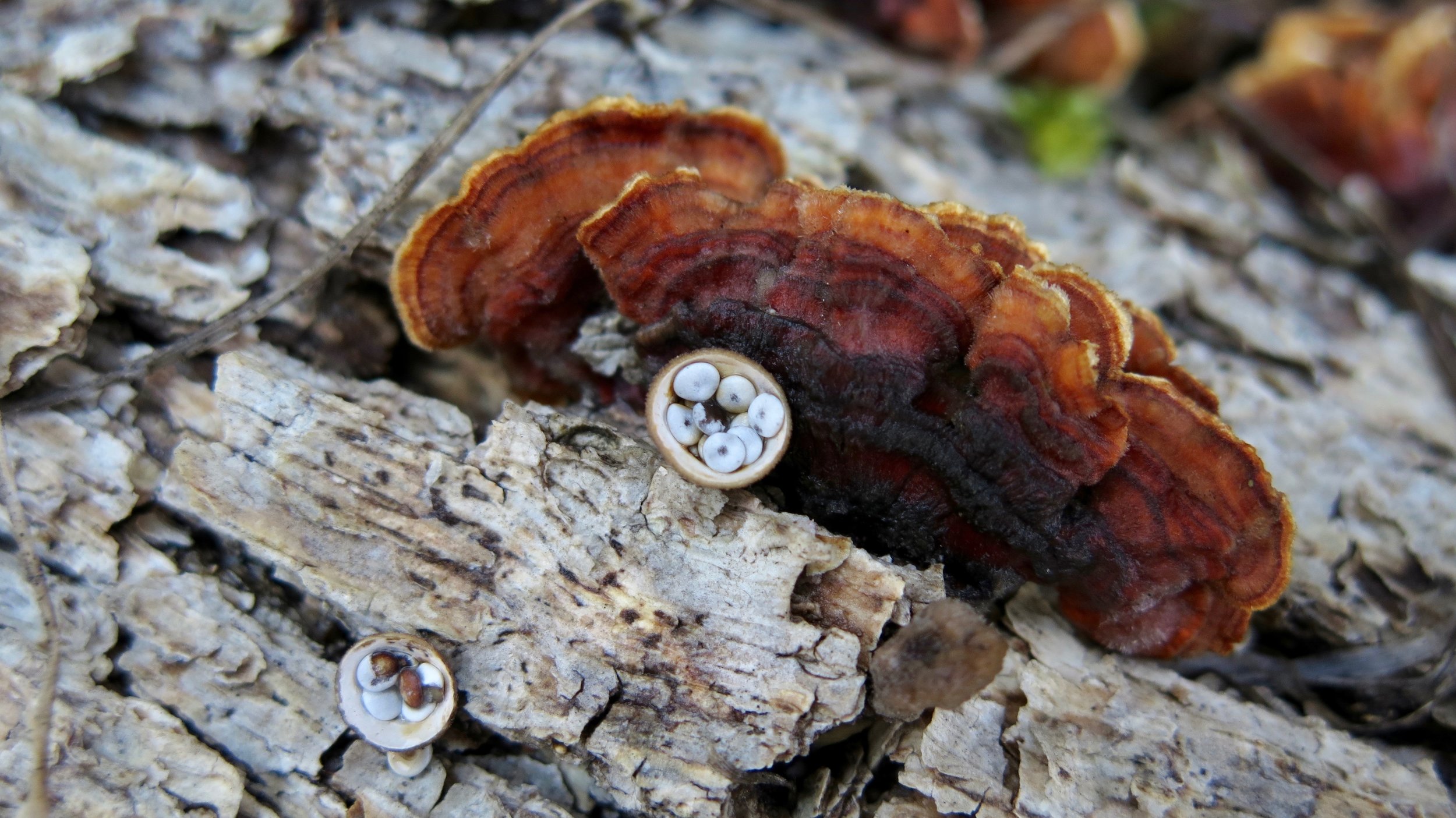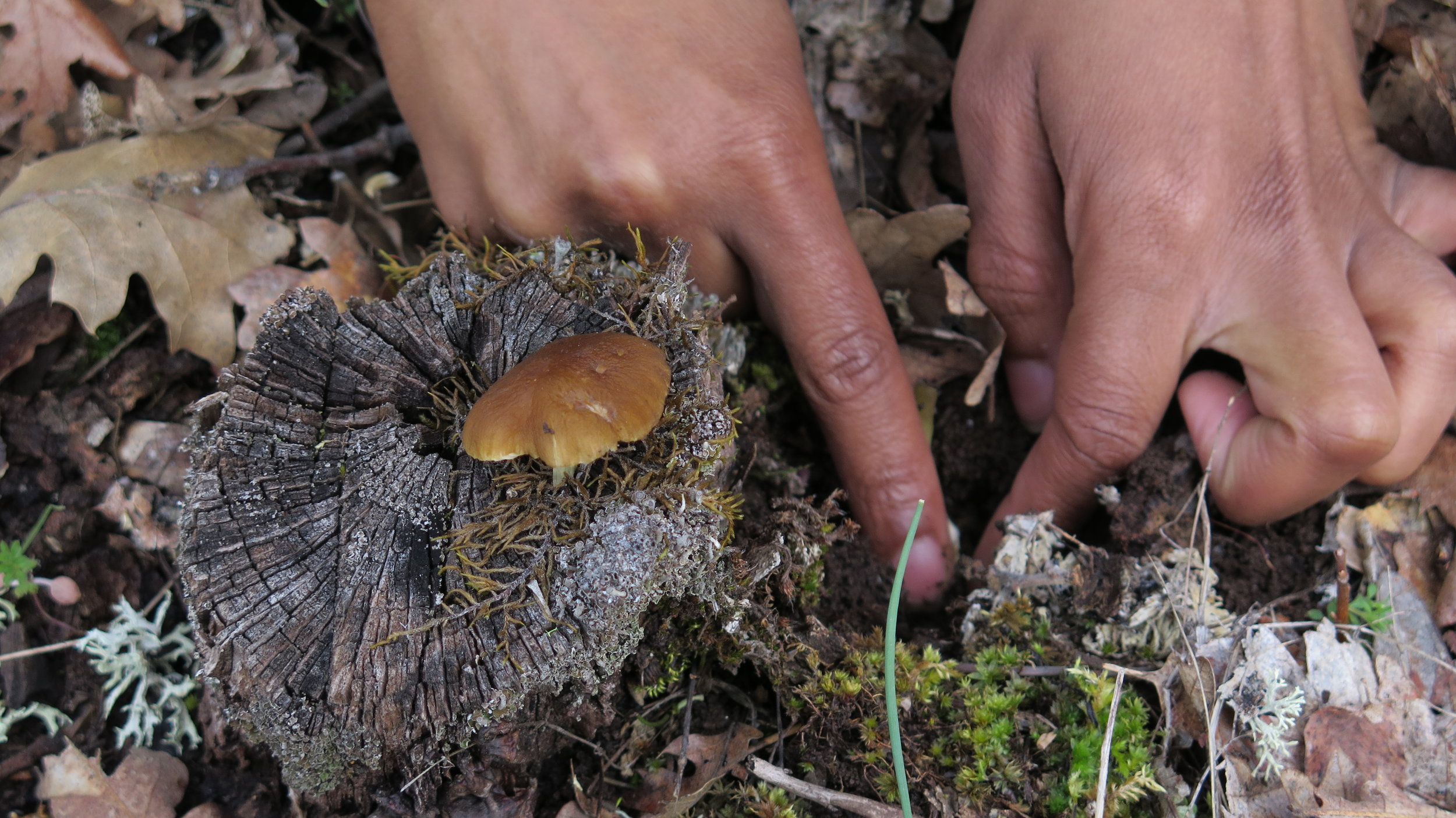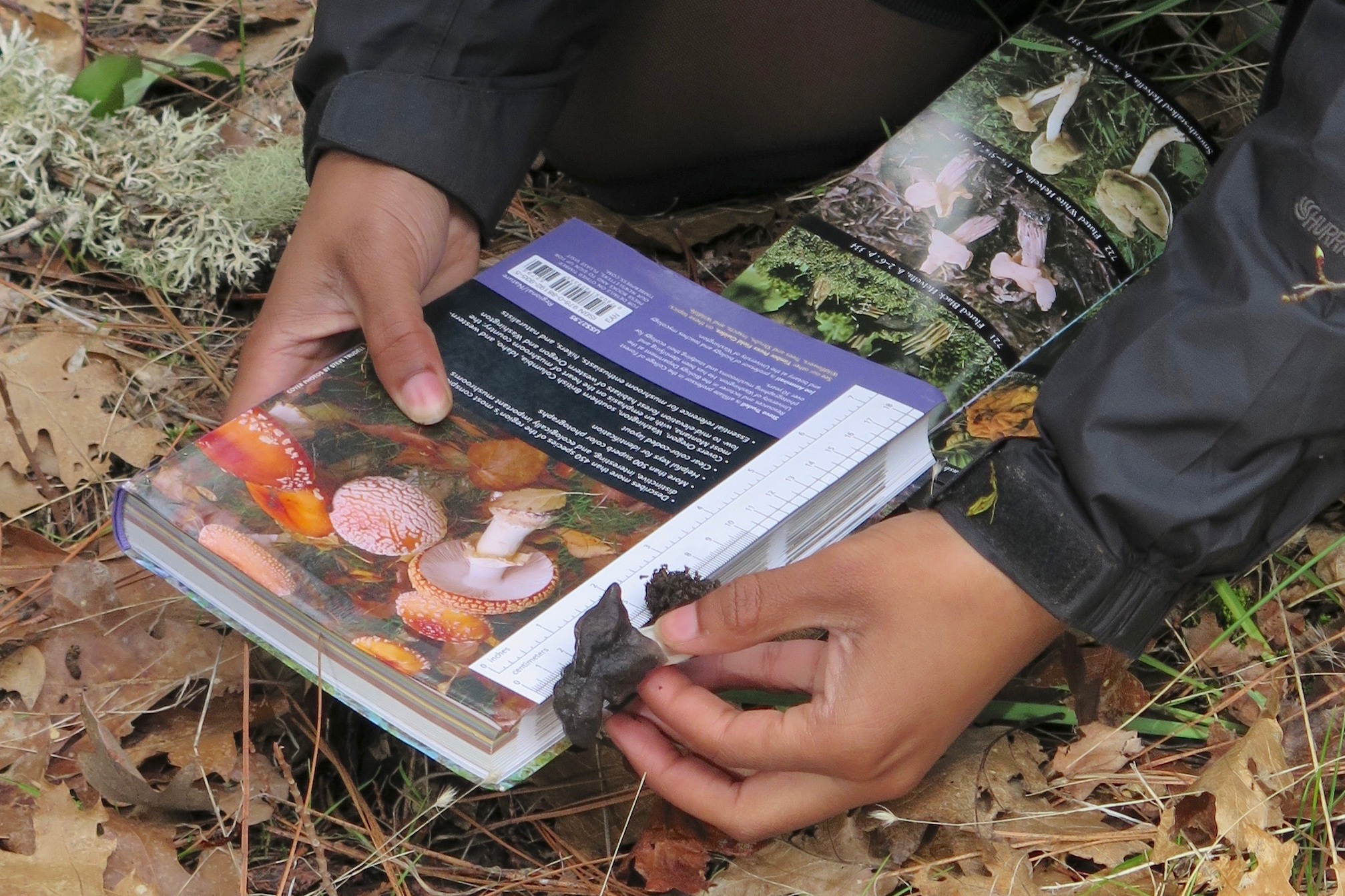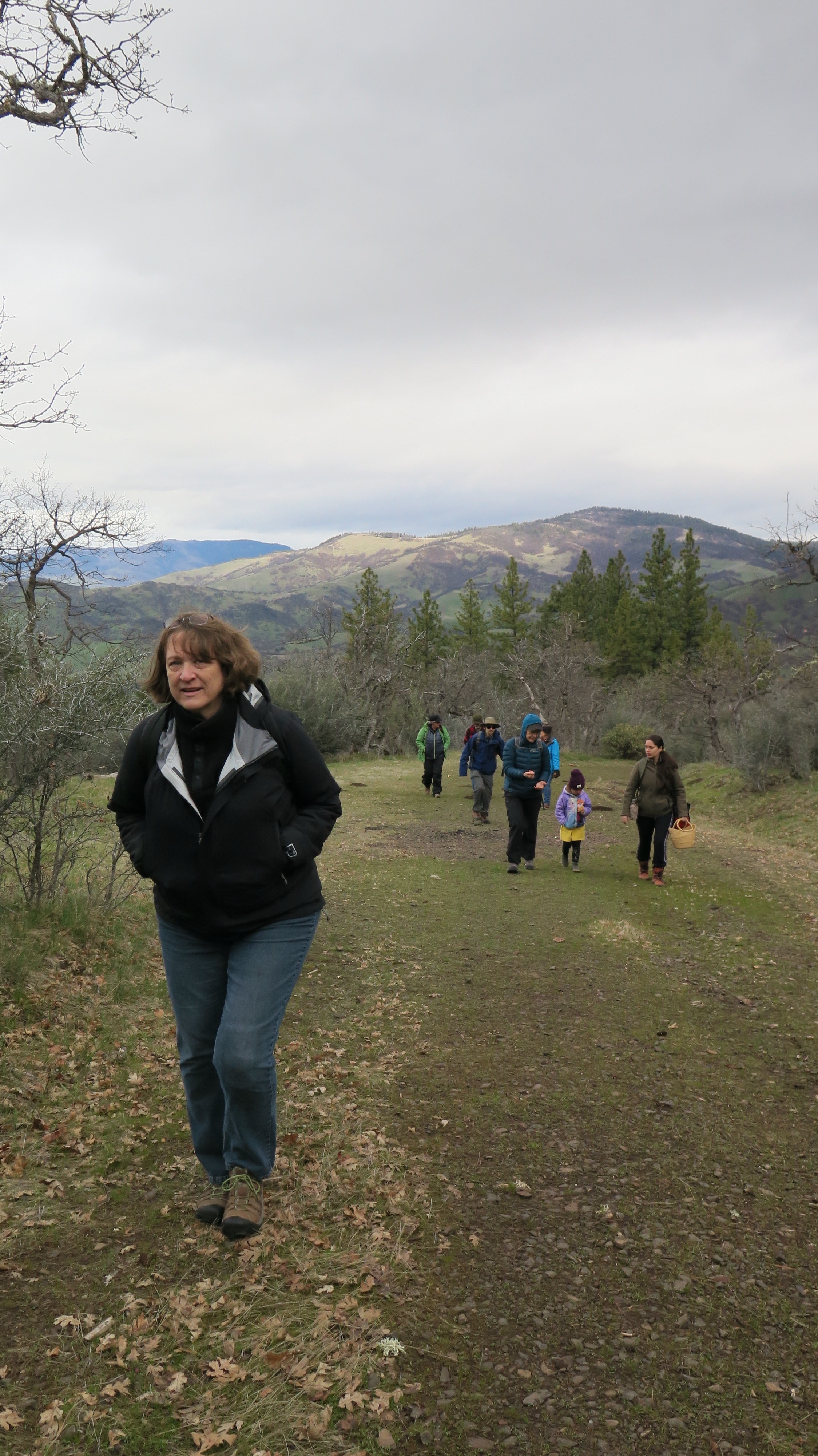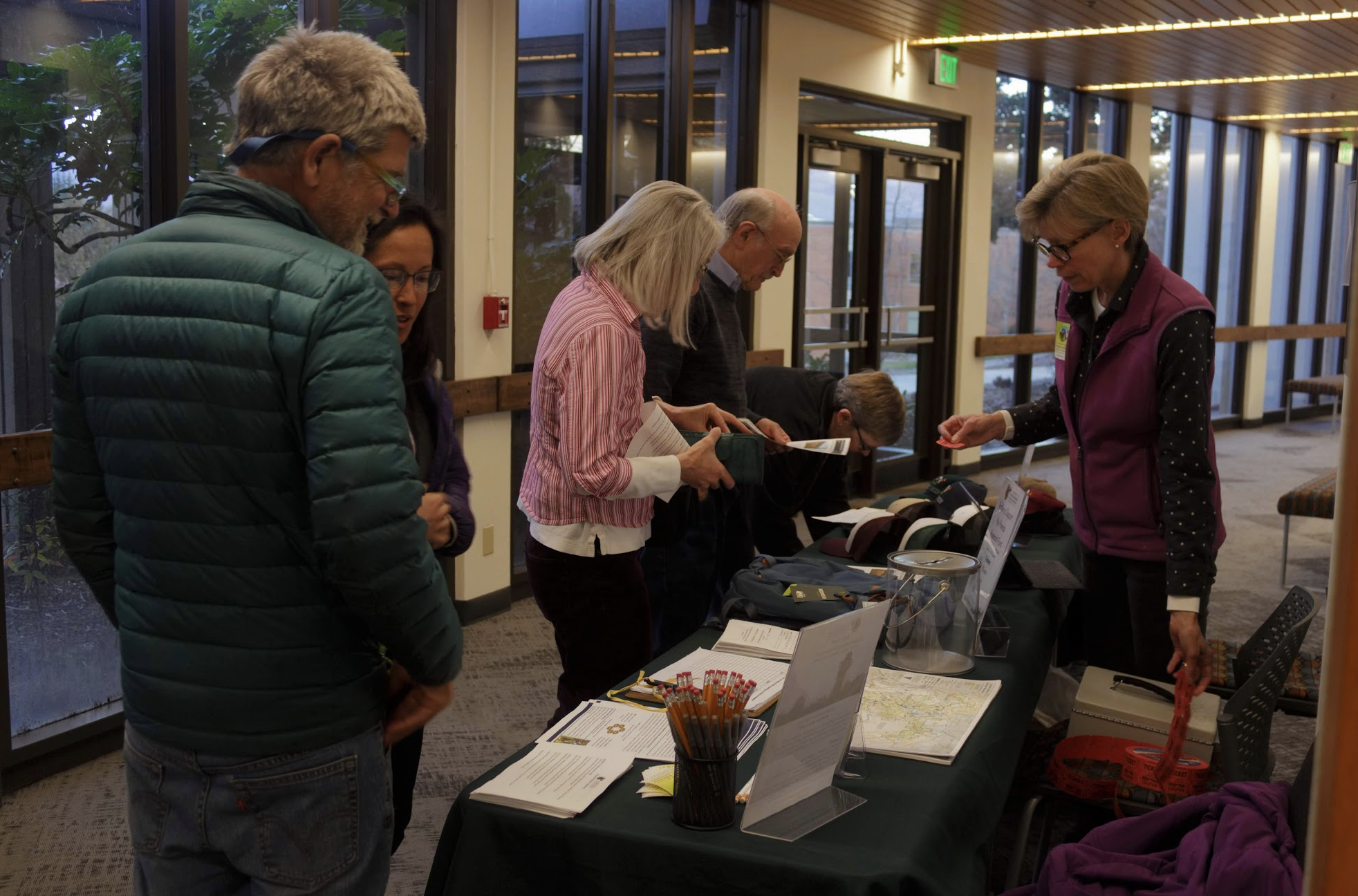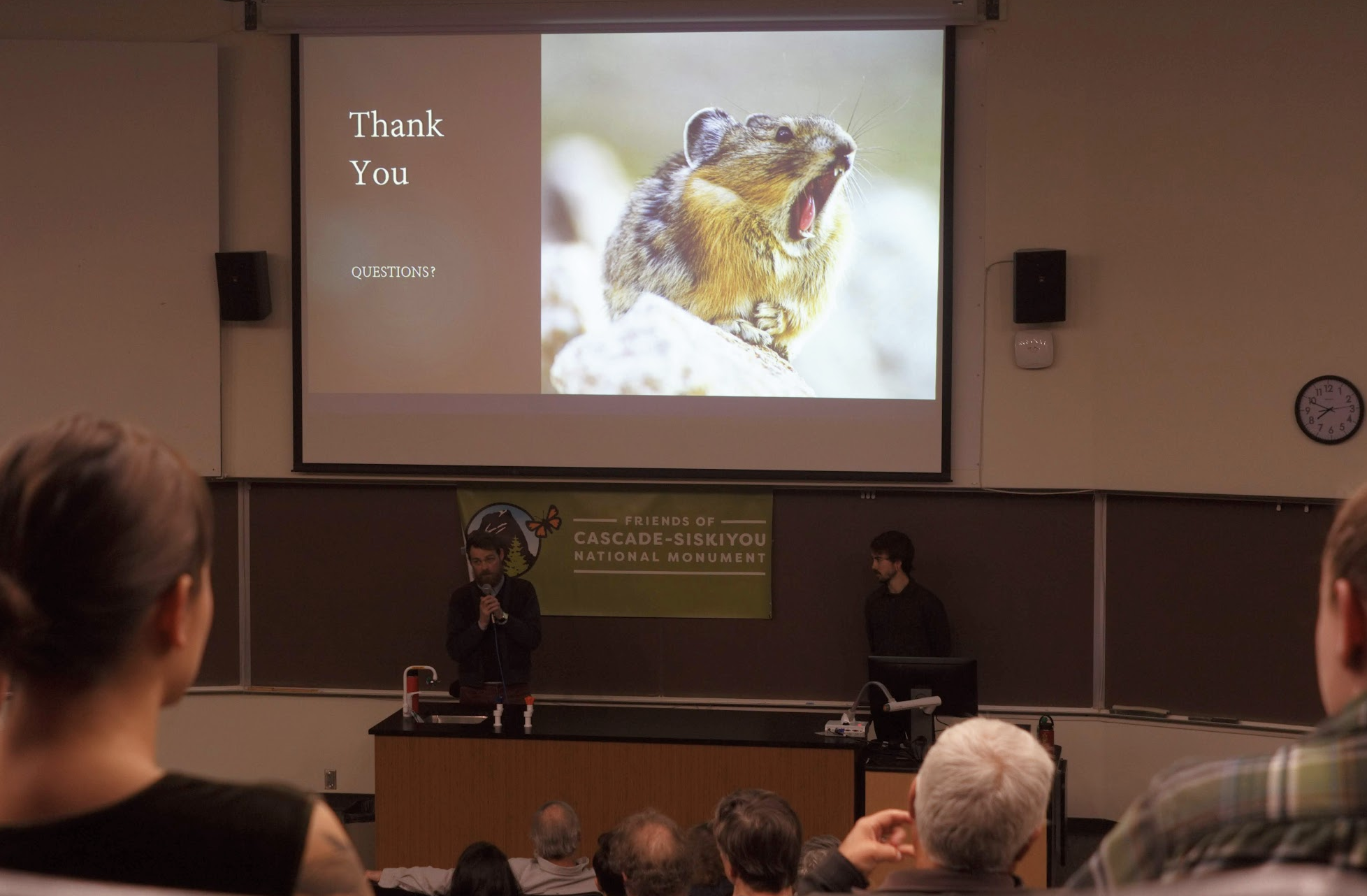PLEASE REGISTER TO GET LINK TO FREE LECTURE
Student Board Members Channel Attention to Monument
2020 Monument Research Symposium organizers and student board members Monique Streit and Courtney Buel with chair Terry Dickey and Jackie Markin, co-chair (2018-2020). WChin photo
Just two weeks before the Covid pandemic hit Ashland in March 2020, the Friends last gathered together publicly as a group for the annual Monument Research Symposium.
Student board members Courtney Buel and Monica Streit were able to present student researchers from as far away as an Internet café in rural Guatemala via Zoom to the audience sitting in the SOU Science auditorium. Four student researchers, funded by a Friends Research Fund were presenting their final reports about the Monument.
At the end of her term in August 2020, Courtney Buel reported, "I was able to join the Friends of the Cascade-Siskiyou National Monument as a student board member during my 18-month stint at Southern Oregon University while pursuing my graduate degree in Environmental Education. As soon as the opportunity was presented to me, I knew this was an experience that I could not pass on."
"As a board member, I've been able to lend my hand in various projects. My most esteemed moments were working with fellow student board member Monique Streit to plan, coordinate, and host the 2020 Monument Research Symposium. I am so grateful for the opportunity to work with the four brilliant student researchers that presented at this Symposium."
In the belief that students can expand the leadership capacity of community and public lands, the Friends have recruited and appointed a student board member since 2015.
Students bring their own life experiences and perspectives to advance Friends capacity to advocate on behalf of the Cascade-Siskiyou National Monument. Alexandra Harding, the first student board member initiated the first Giving Tuesday fundraiser for the Friends.
Former Sierra Club staff member Shannon Browne advanced from being a student board member to become the Friends' first executive director. She coordinated Friends' advocacy efforts with other community groups during the campaign for the 2017 Monument expansion. She went on to recruit and mentor students to work on the Friends Hike & Learn, BioBlitz and the Friends' first Gala fundraiser in 2019.
SOU graduate students Jacqueline Blanchette and Laney Marcotte joined the Friends Board in October. The ongoing pandemic requires everyone to conduct business with an abundance of caution. Meetings are conducted socially distanced. Jacqueline graduated from SOU with a B.S. in Environmental Science & Policy and a Certificate in Sustainability Leadership. Elaney has taught students about science and the environment through place-based education in Texas and Wyoming. Jacqueline and Elaney are working toward an MS in Environmental Education at SOU.
Courtney reflected on her year, "This experience proved the impact the Friends Research Fund has in supporting budding scientists and jump-starting their careers. In addition to the Symposium, I participated in the Fall Birds Hike and Learn, where I saw my first Hairy Woodpecker!"
"Additionally, I was able to help plan and put on the Friend's first Gala event, an exciting and successful time. While my time with the Friends is short, it was still nonetheless jam-packed."
In December 2020, student board members Courtney Buel and Monique Streit will each earn a M.S. in Environmental Education as well as a Certificate in Nonprofit Management at Southern Oregon University.
Monument RE-OPENS
Bureau of Land Management Medford District re-opens public lands
Medford, Oregon – Thanks to recent rains and an increase in availability of initial attack resources to respond to new starts, the Bureau of Land Management Medford District is rescinding public lands closure notices across much of the District. Public lands closures remain in effect near the Slater Fire and the South Obenchain Fire.
Despite the re-opening of these public lands, fuel conditions remain dry and new starts are possible. Help us thank firefighters, and protect your community, by doing your part to prevent new fires by following the public use restrictions that are still in place. Campfires are prohibited on all public lands in the Medford District, and smoking is only allowed while inside a vehicle or in an area that is at least three feet in diameter clear of flammable vegetation.
The Bureau of Land Management Medford District works with the Oregon Department of Forestry to provide initial attack resources when new fires start. A combination of heavy smoke, limited resource availability and low fuel moisture content prompted the initial public lands closures. Significant progress and slow fire growth on the Slater Fire and South Obenchain Fires has also increased availability of resources should a new fire occur. The shorter days, higher humidity recovery at night and lower temperatures are important factors that fire managers consider when determining fire risk.
Public lands closures remain in effect near the Slater Fire and the South Obenchain Fire to reduce interference with emergency crews and allow for fire suppression and burned area recovery. Members of the public may not enter closed areas, all uses are prohibited in the area, and Bureau of Land Management roads and trails are closed.
The Slater Fire Closure includes all Bureau of Land Management public lands south of Cave Junction and south of Highway 46 from Cave Junction east to the boundary of the National Forest. The South Obenchain Fire closure includes all public lands south of Highway 62, north of Highway 140, east of Range 01W (approximately 2.5 miles west of Shady Cove) and west of Range 02E (approximately 2 miles east of Butte Falls).
Maps of the closure areas are available on the Bureau of Land Management’s website: https://www.blm.gov/programs/public-safety-and-fire/fire-and-aviation/regional-info/oregon-washington/fire-restrictions
Please call 911 to report any signs of new fires.
Thank a firefighter by observing public use fire restrictions to help us limit new starts during this time:
Campfires or any other type of open fire, including the use of charcoal briquettes, is prohibited on BLM-managed land.
Power-driven machinery is prohibited in forested areas. This restriction includes power saws; equipment used for the cutting, grinding, or welding of metal; mowing of dry, cured grass with power equipment; and the use of any other spark-emitting equipment using an internal combustion engine.
Smoking is only allowed while inside a vehicle or while stopped in an area at least three (3) feet in diameter that is clear of flammable vegetation.
Operating a motor vehicle and parking off road (including motorcycles and all-terrain vehicles) is only allowed on roadways clear of flammable vegetation.
Using fireworks, exploding targets, or tracer ammunition is prohibited.
Using a chainsaw or other equipment with internal combustion engines for felling, bucking, skidding, woodcutting, or any other operation is prohibited.
Welding or operating a torch with an open flame is prohibited.
Visitors to lands managed by the Bureau of Land Management are also required to carry tools with them to ensure small fires can be put out quickly, including a shovel, axe, and at least one gallon of water or a 2.5-pound fire extinguisher.
A list of personal use restrictions, as well as closure orders, are available at https://www.blm.gov/programs/public-safety-and-fire/fire-and-aviation/regional-info/oregon-washington/fire-restrictions. You can also follow us on Facebook and Twitter @BLMOregon.
-BLM-
Kyle Sullivan, Public Affairs Specialist
Bureau of Land Management - Medford District Office
(o) 541-618-2340 (c) 541-613-1418
Monument CLOSED for Extreme Fire Activity
Bureau of Land Management Ashland Field Office issues emergency fire closures
Medford, Oregon – As a result of extreme fire activity, the Bureau of Land Management Medford District has temporarily closed all BLM-administered public lands from Township 38S south to the California border and from Range 2E east to the Klamath County border.
This closure includes the portions of Cascade Siskiyou National Monument in Jackson County and areas near the Grizzly Creek fire. Members of the public may not enter closed areas, and all uses—including hunting and dispersed camping—are prohibited. All Bureau of Land Management roads and trails in the area are closed, including the Grizzly Peak trailhead, Hobart Bluff Trailhead, Hyatt Lake, the Pacific Crest Trail and the Soda Mountain Wilderness. See the Map of Ashland Closures of affected areas.
Maps of the closure areas are available on the Bureau of Land Management’s website: https://www.blm.gov/programs/public-safety-and-fire/fire-and-aviation/regional-info/oregon-washington/fire-restrictions
Public and firefighter safety are the highest priority. The extreme fire danger and fuels conditions have prompted the closure of these public lands to help with initial attack resources available to respond to new starts. The Bureau of Land Management continues to monitor fuels and resource conditions and will consider modifying closures if their impacts are in alignment with sound risk management practices.
On September 12, the Bureau of Land Management closed all public lands south of Grants Pass, Interstate 5, and U.S. Route 199 to the border of the Rogue River-Siskiyou National Forest as well as near the South Obenchain Fire outside of White City and the Slater Fire along the California state line.
Multiple new fires started in early September on Bureau of Land Management, U.S. Forest Service, and private lands in the region have prompted Level 3 “Go” evacuations. Moderate to heavy smoke impacts from the fires are expected to continue.
Personal safety is paramount. Stay informed on air quality ratings and more by visiting the Oregon Smoke Blog at http://oregonsmoke.blogspot.com/. Learn how to stay safe from wildfire smoke at https://www.cdc.gov/air/wildfire-smoke/default.htm.
Weather and fuel conditions remain favorable for continued fire spread. Nearby residents and visitors to the area are encouraged to check with local emergency officials for the latest information on evacuations.
For the latest road and weather condition updates, visit https://www.tripcheck.com/.
Additional fire information is available on Inciweb:
South Obenchain Fire: https://inciweb.nwcg.gov/incident/7185/
Slater Fire: https://inciweb.nwcg.gov/incident/7173/
Call 911 to report any signs of new fires.
Please avoid outdoor recreation during these times and observe public use restrictions to help us limit potential new starts during this time:
Campfires or any other type of open fire, including the use of charcoal briquettes, is prohibited on BLM-managed land.
Power-driven machinery is prohibited in forested areas. This restriction includes power saws; equipment used for the cutting, grinding, or welding of metal; mowing of dry, cured grass with power equipment; and the use of any other spark-emitting equipment using an internal combustion engine.
Smoking is only allowed while inside a vehicle or while stopped in an area at least three (3) feet in diameter that is clear of flammable vegetation.
Operating a motor vehicle and parking off road (including motorcycles and all-terrain vehicles) is only allowed on roadways clear of flammable vegetation.
Using fireworks, exploding targets, or tracer ammunition is prohibited.
Using a chainsaw or other equipment with internal combustion engines for felling, bucking, skidding, woodcutting, or any other operation is prohibited.
Welding or operating a torch with an open flame is prohibited.
Visitors to lands managed by the BLM are also required to carry tools with them to ensure small fires can be put out quickly, includinga shovel, axe, and at least one gallon of water or a 2.5-pound fire extinguisher.
A list of personal use restrictions, as well as closure orders, are available at https://www.blm.gov/programs/public-safety-and-fire/fire-and-aviation/regional-info/oregon-washington/fire-restrictions. You can also follow us on Facebook and Twitter @BLMOregon.
BLM - Medford District Office
September 16, 2020
Media contact: Kyle Sullivan, (541) 618-2340
FILM: The Monument at Klamath Independent Film Festival 2020
Congratulations to Crystal Nichols, filmmaker and producer of The Monument, a film about the Cascade-Siskiyou National Monument. The Monument is showing at the Klamath Independent Film Festival 2020. She received a 2019 Friends Research Fund grant, awarded to undergraduate or graduate students for faculty-supervised projects that enhance an understanding, appreciation, preservation, and/or protection of the Cascade-Siskiyou National Monument.
Notes by Crystal Nichols
Crystal Nichols filming on location at the Cascade-Siskiyou National Monument. Nichols image.
I had the Klamath Independent Film Festival on my mental radar before I even finished creating The Monument, with the support of the Friends. I lucked out and found the submission opportunity for the film festival on the very last day of the deadline. About a month later, I learned that the film had been officially selected. I am honored and so excited to have the film showcased to the regional community since the film festival will be both in-person and virtual this year.
I had a video call with the executive director of KIFF to complete a Q&A session about the making of The Monument. This Q&A session will be played at some point during the festival. He seemed thrilled to be able to include a film that showcases the Klamath region! My film will be competing for various awards that are a part of the festival, but I will not know the results until the festival.
The Klamath Independent Film Festival is proudly the only film festival to showcase films that were either made in Oregon or whose filmmaker is from Oregon. The festival is in its eighth year and it will be taking place from September 18-20, 2020. Right now, their goal is to have the festival be in-person, with a large theater venue that can accommodate a lot of people even while social distancing. Just in case, the festival will also be available virtually.
IF YOU GO:
More information and tickets at the Klamath Independent Film Festival.
From September 18-20, 2020 in Klamath Falls, Oregon.
Nature Scavenger Hunt - Kids and Families
Do you or your kids enjoy exploring nature? If so, this scavenger hunt is for you!
Take your family out to one of the Cascade-Siskiyou National Monument’s many trails to explore, You can find trails on the Monument map.
Nature Scavenger Hunt.
Before going to the Monument
Download and Print the Nature Scavenger Hunt
Make a copy for each person. You only need to print one page of the directions. Bring pen or pencils—colored ones if possible. A writing board or piece of cardboard may make it easier to write on.
See the hike preparation tips to help you get ready for hiking in the Monument. This tells you about the Monument limited facilities, taking care on your hike, and what to bring:
Bring plenty of water
Lunch and snacks
Additional items: Hat, Sunscreen, Walking Sticks, Camera, Binoculars, Hand Lens, Checklist.
Wear sturdy shoes.
Any protective clothing
On the trail
Observe what is around you, and explore! Write the things you see on the Nature Scavenger Hunt. Afterwards you can compare and talk about what each person saw.
This Nature Scavenger Hunt can be used anywhere and is suitable for all ages.
Enjoy your time outside discovering new plants and animals!
Thanks to the Southern Oregon University Environmental Education graduate students for making this activity sheet to use in the Monument.
Virtual Monumental Summer Solstice
We are grateful to our community friends and partners who have curated and organized virtual experiences to mark the 20th Anniversary of the Cascade-Siskiyou National Monument. They have taken extra efforts to provide you with access to their presentations online. Enjoy and share these virtual experiences to advocate for the Monument, our protection of public lands and our communities.
We thank you for your continued support in funding our education and conservation programs. We couldn’t do this work without you.
at Schneider Museum of Art website
Celebrating Wild Beauty, curated by Museum Director Scott Malbaum
with the Monument’s 2019 Artist in Residence Mark Tribe
at Project Space, Talent website
Land That I Love: Scenes from Cascade-Siskiyou, curated by artist Sarah Burns
with the Monument’s 2017 Artist in Residence Matt Witt
Welcome Our New Executive Director
Lisa James has been appointed the new executive director of the Friends of Cascade-Siskiyou National Monument. Lisa says,
Lisa James, Executive Director, Friends of CSNM
“I am thrilled to join the Friends of the Cascade-Siskiyou National Monument (CSNM) as Executive Director at this significant 20th Anniversary. Despite challenging restrictions on activities for everyone, I will be working closely with the dedicated Board of Directors and other non-profits to promote the protection, restoration, and conservation of the Cascade-Siskiyou National Monument (CSNM).
I bring more than thirty years of experience in executive nonprofit management. I recently served as Executive Director of the Lan Su Chinese Garden in Portland, a botanical marvel, and three years with the Portland Japanese Garden orchestrating their $30 million expansion campaign.
I’ve consulted with the Crater Lake National Park Trust, Jefferson Nature Center, Coyote Trails School of Nature, ScienceWorks Museum, Ashland Art Center, Ashland Schools Foundation, and the KSC Buddhist Center. I also spent 6 years with my alma mater SOU as the VP for Institutional Advancement and E.D. of the SOU Foundation where I completed their campaign to build the Center for the Arts.
My husband Sam and I live on the Rogue River. We enjoy rafting the wild and scenic Rogue, Klamath and Deschutes Rivers, hiking the nearby Tablerock Mountains, and fishing in our regional lakes and Pacific Ocean. I look forward to learning more about the vast biodiversity of the CSNM and working with our community supporters on educational and research projects, recreational hikes, special events, and more.”
June 9, 2020 - Take Care.
20th Anniversary - Cascade-Siskiyou Monument
Emigrant Creek © Matt Witt, 2017 Artist in Residence, Cascade-Siskiyou National Monument
“In difficult times like these, protecting and enjoying natural beauty and diversity -- as the Monument has done for 20 years -- is more important than ever.”
Take Care. Now and for Our Future Generations
Thank you for being a Friend to Cascade-Siskiyou National Monument.
As we learn more about the Monument's unique biodiversity, we create an enduring relationship with the land that enables us to share and pass on this heritage to future generations.
Long before us, the Takelma, Klamath, and Shasta people are the traditional caretakers of this land.
The Cascade-Siskiyou National Monument was established on June 9, 2000, with the primary goal of protecting this area's outstanding collection of species and ecosystems. This biological diversity is owed, in part, to the millions-years old volcanic rocks and uplifted mountains.
It has one of the most diverse ecosystems found in the Cascade Range and is home to a spectacular variety of rare and beautiful species of plants and animals. Because all parts of an ecosystem--animals, plants, microbes, and humans--are interconnected, biodiversity is an asset we can take care of for our planet.
________________________________
2020 was a time of social distancing due to the Covid-19 pandemic. Although events in the Monument were canceled, Zoom video conference meetings could be accessed by anyone with an online link. Public programs to mark the 20th anniversary of the Cascade-Siskiyou National Monument were postponed. Oregon Governor Kate Brown issued Executive Order 20-24, on March 8 and extended through July 6. This declaration of emergency banned gatherings of 25 people or more through September 2020. Despite the Covid-19 threat, racial injustice protests (for #Black Lives Matter) spread to Oregon small towns, including Medford, after the George Floyd death by deadly police force. The racial and ethnic disparities of access to health care, justice and education are revealed in other areas, including the environment.
Discover Student-Led Research in the Monument
From geologic surveys to small mammal trapping to documentary film-making, the Friends Research Fund grantees were hard at work these past several months collecting research for their projects.
Each year, the Friends Research Fund awards research grants to undergraduate and graduate students who are interested in pursuing a faculty-supervised project that enhances an understanding, appreciation, preservation, and/or protection of the Cascade-Siskiyou National Monument. Read about the fascinating work our most recent recipients have accomplished below!
Eli Livezey and Mac Patton, are recent graduates of Evergreen State College. Their research focuses on analyzing the genetics of two species of lichen found in the Monument. Their research is advised by Dr. Lalita Calabria.
Over the 2019 summer, Eli and Mac traveled to the Monument and collected specimens of Lipstick Lichen (Umbilicaria phaea var. coccinea) and Common Rock Tripe (Umbilicaria phaea var. phaea). After completing the collection process, they sent the samples to an off-campus lab to have their metagenomes sequenced. The results of this sequencing are still being analyzed. In addition, Eli and Mac are currently trying to isolate and identify the pigment responsible for the red color of Lipstick Lichen using thin-layer chromatography and nuclear magnetic resonance spectroscopy.
Sam Cooke, is a recent graduate of the University of Oregon, graduating with a degree in Geology. Working with his advisor Jad D’Allura, Sam researched different volcanic rocks and mapped their compositions in the Northwest part of the Monument.
Sam’s geologic research in the Cascade Siskiyou National Monument consists of determining spatial and temporal boundaries of volcanic eruptions and subsequent geologic events that occurred in this area beginning approximately 30 million years ago. In addition, Sam has produced a preliminary map of the NW part of the Monument near Grizzly Peak that maps out the Wasson Formation rocks that are south of Dead Indian Memorial Highway. The map is based on quick road traverses, LiDAR, aerial photo interpretation, and limited field checking. Samples that were collected during his field research are still waiting to be made into thin sections for microscopic and geochemical analysis. This analysis will help determine the age dates of the samples in order to create a higher resolution chronology.
Crystal Nichols, earned her undergraduate degree in Aquatic Biology from Ball State University, and she recently received her M.S. in Environmental Education from Southern Oregon University. Crystal’s research led her to create a documentary about the Monument titled The Monument. Her project is supervised by Dr. Stewart Janes. Crystal is currently in the final editing stages of the film and will be debuting the film at the Monument Research Symposium.
“The creation of this short film is the result of nearly 1,200 miles of driving, 80 miles of hiking, and innumerable hours editing down nearly 10 hours of raw footage. The Monument has taken me on an exciting exploration of more of the Monument than I ever thought I would experience. My hope is that it will do the same for those who watch the film. But my hope for the film is not to tell the whole story of the Monument, but to ignite an appreciation for the wonder and importance of the Monument, and the variety of life it represents.”
Clare O’Connell, is a Humboldt State University graduate, who graduated Summa Cum Laude this past May with a degree in Zoology. She is now pursuing her Master’s degree in Wildlife Conservation Ecology at New Mexico State University. Clare’s research in the Monument took place during the summer of 2019, with her research focusing on small mammal trapping under the advising of Dr. Melissa Hawkins.
During her summer research, Clare collected data on the Tamias siskiyou chipmunk. This species belongs to the Townsend’s chipmunk species complex, which includes a number of cryptic Pacific Northwestern “species” which currently have undeciphered genetic relationships. Clare’s research analyzes five of the cryptic species within the complex, deciphering phylogenetic and morphometric components.
Come and hear more about these student’s research findings at our annual Monument Research Symposium at Southern Oregon University Science Auditorium on March 5th, 2020! Find out more about this event here.
Interested in helping foster students’ research in the Cascade-Siskiyou National Monument? Donate to the Friends Research Fund today!
- Written by Courtney Buel, Student Board Member, Friends of Cascade-Siskiyou NM
Photos by student researchers







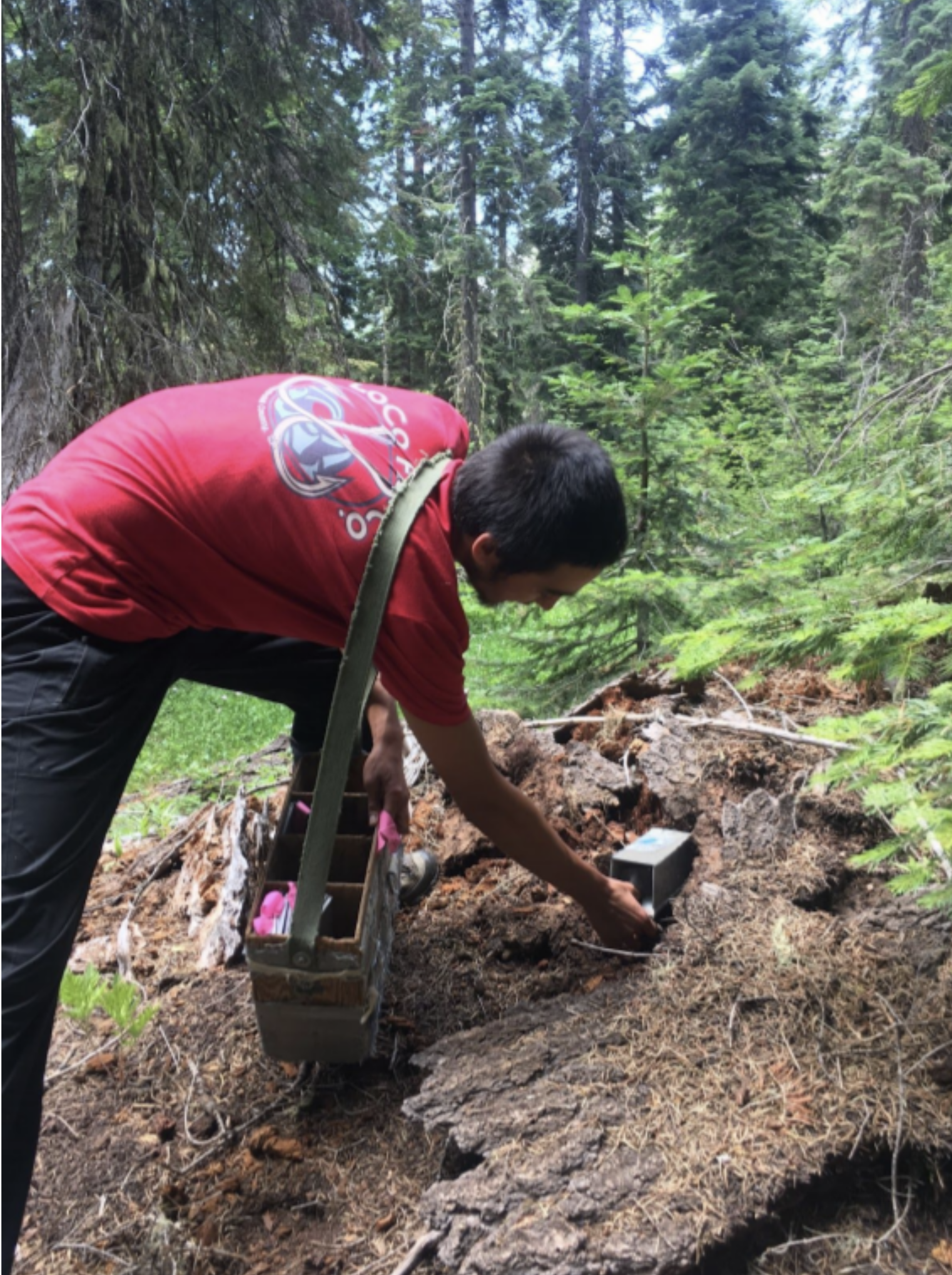


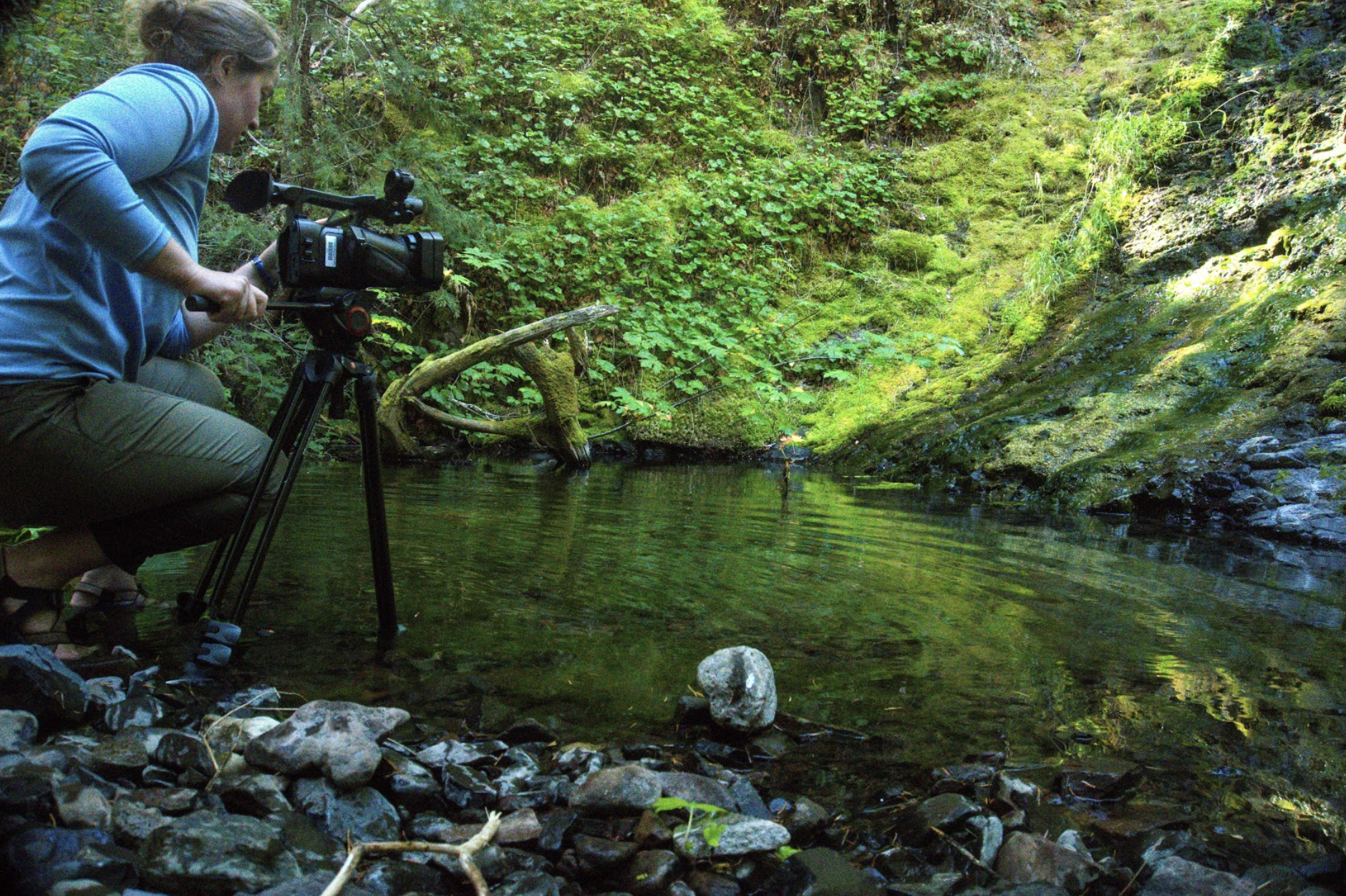
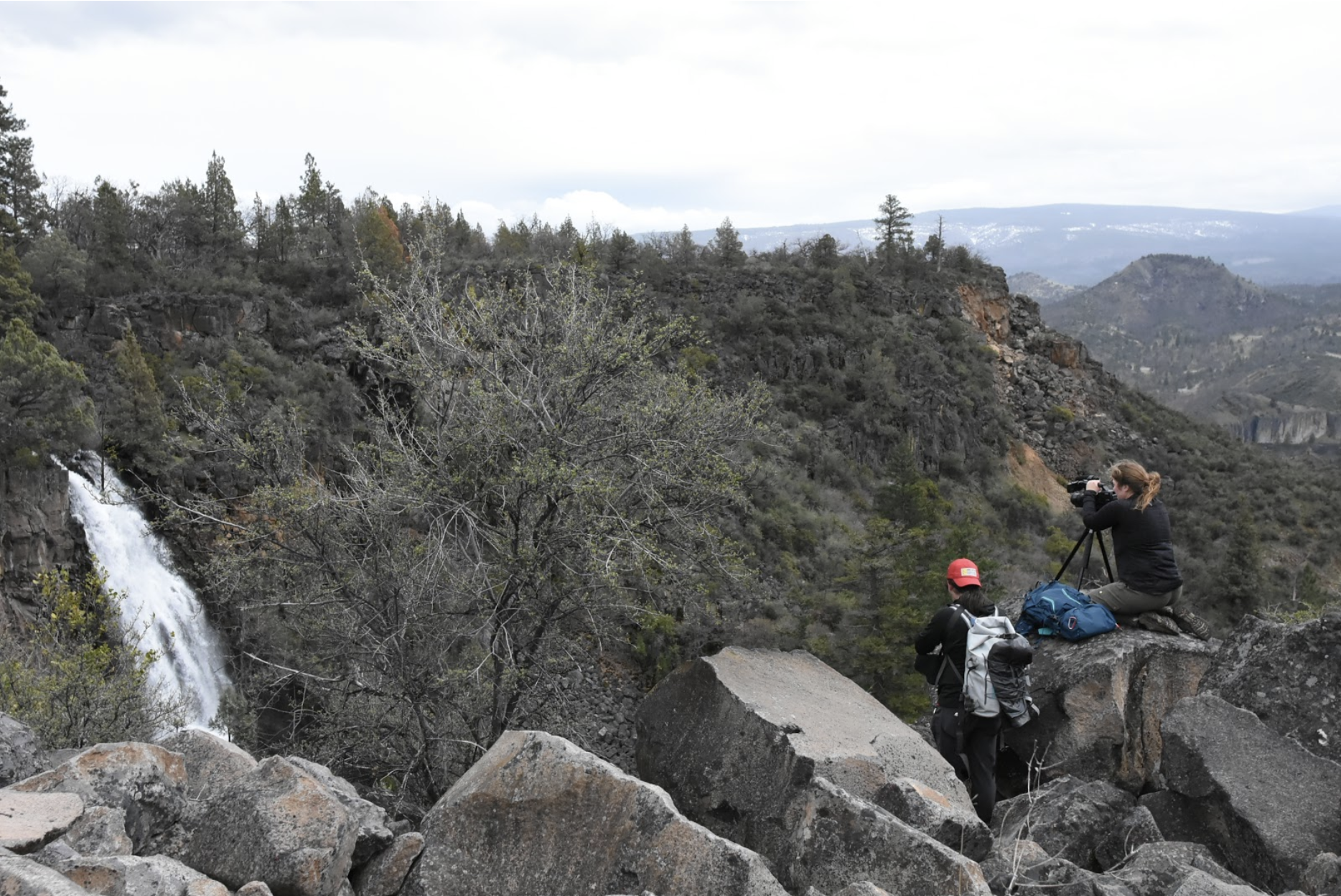
National Monument Public Lands Day 2019
On behalf of the Friends of Cascade-Siskiyou National Monument, Southern Oregon Land Conservancy (SOLC), and the BLM Monument staff, thank you for participating in our National Public Lands Day event on October 26th at Cascade-Siskiyou National Monument!
This year, our goal was to remove fencing on boundary lands between Sky King Cole and the Monument in the Pilot Rock area. Sky King Cole is a beautiful 1312-acre private property conserved with a conservation easement held by Southern Oregon Land Conservancy. The fencing was first installed by the owners to keep out open range cattle, but now that the cattle have been removed as a part of the long-term restoration of the area, the fencing no longer served a purpose and created a wildlife hazard. By removing this fencing, we were able to free up the movement and migration of the animals that call the Monument home.
Even though the day was a chilly one, we were able to remove 3400 feet of barbed wire fencing with the help of over 30 volunteers!
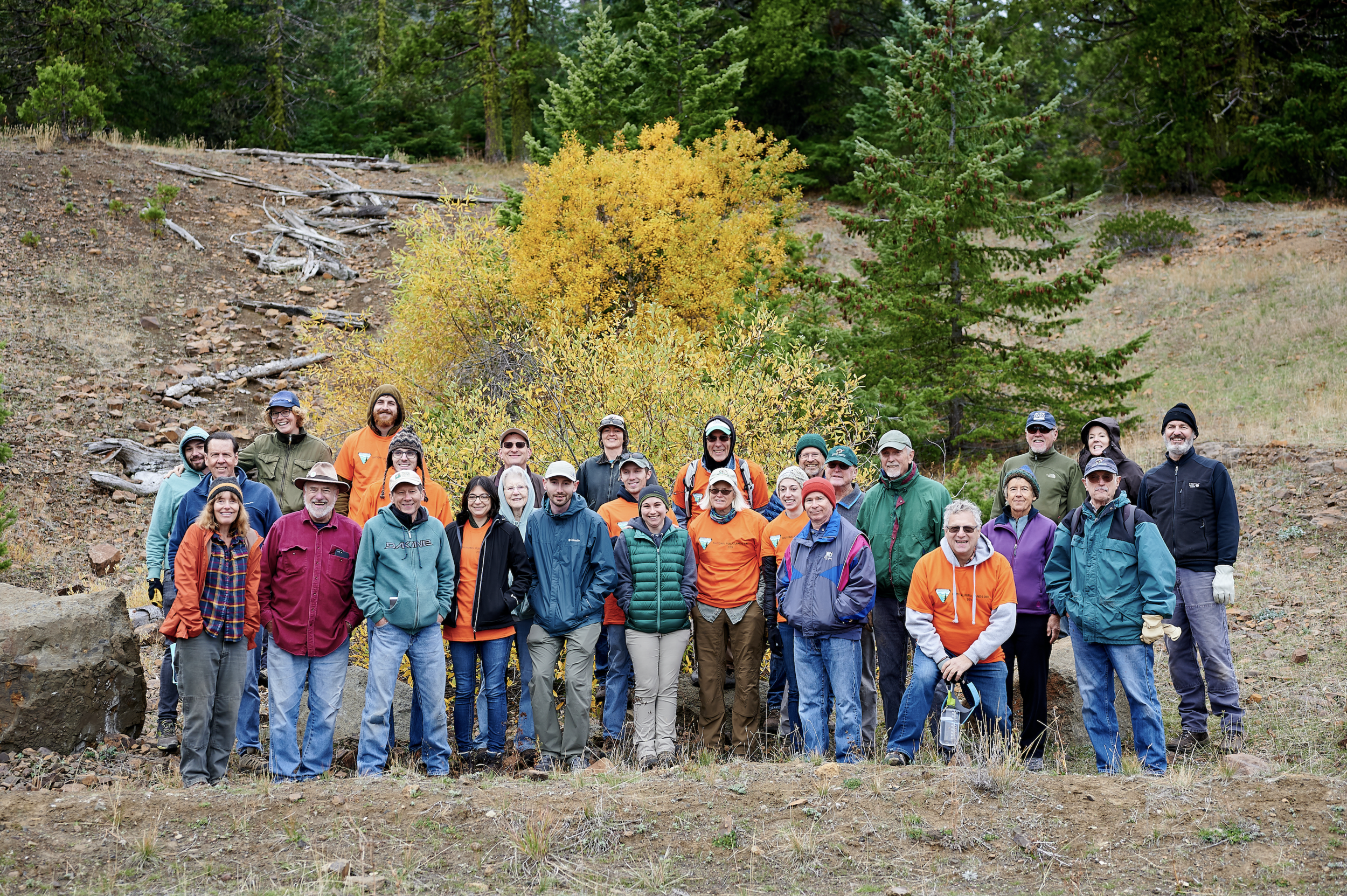
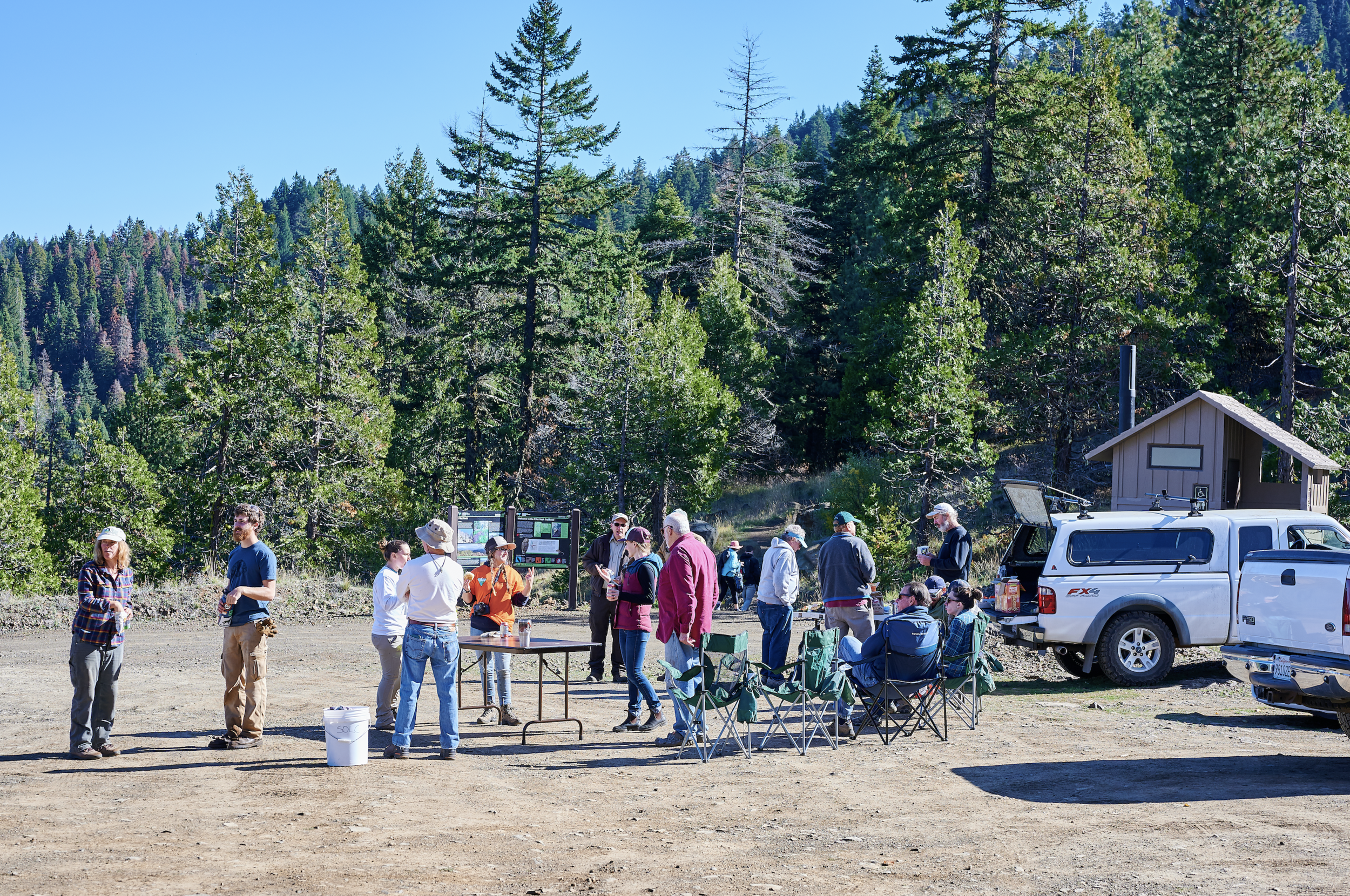
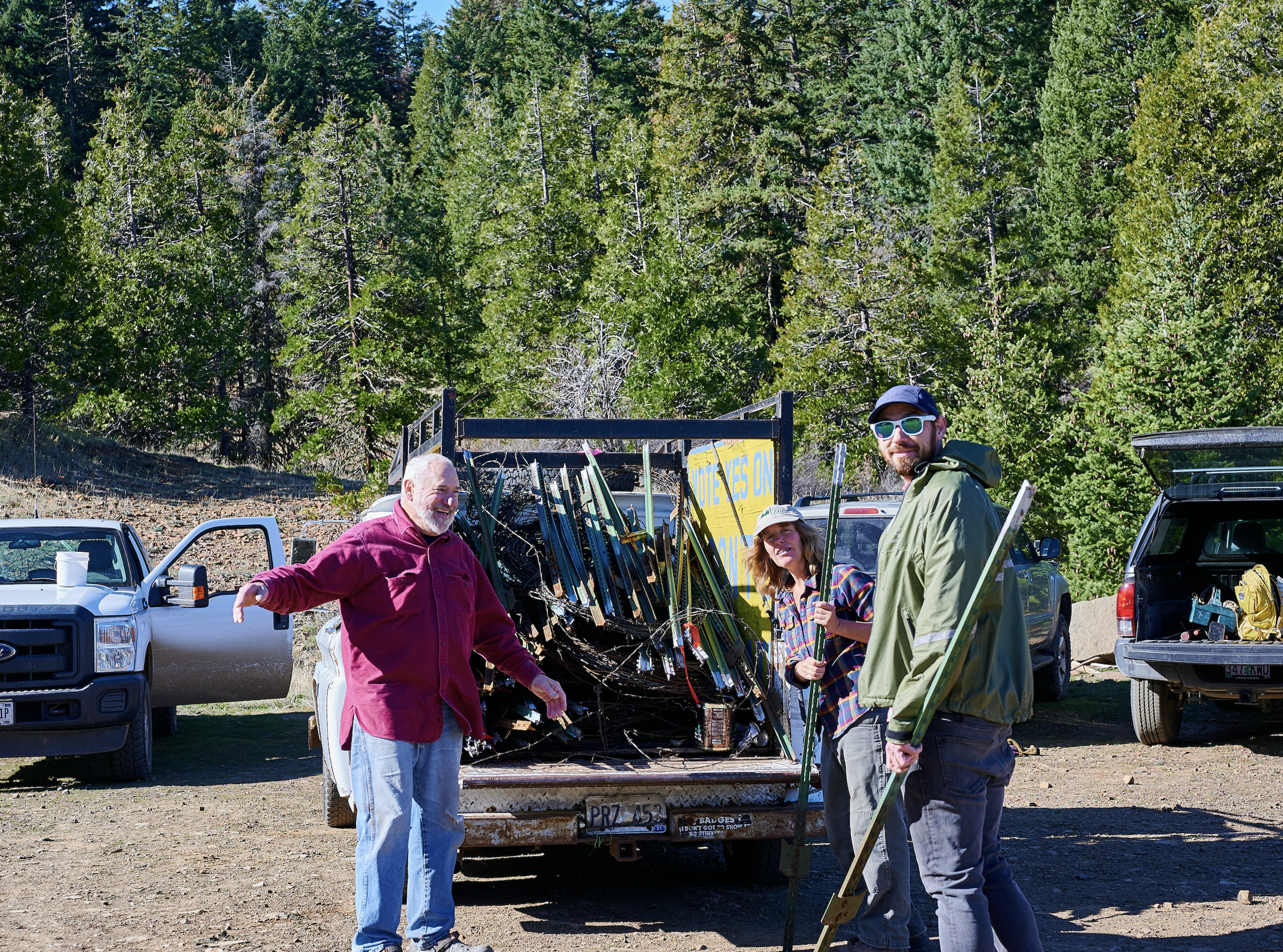
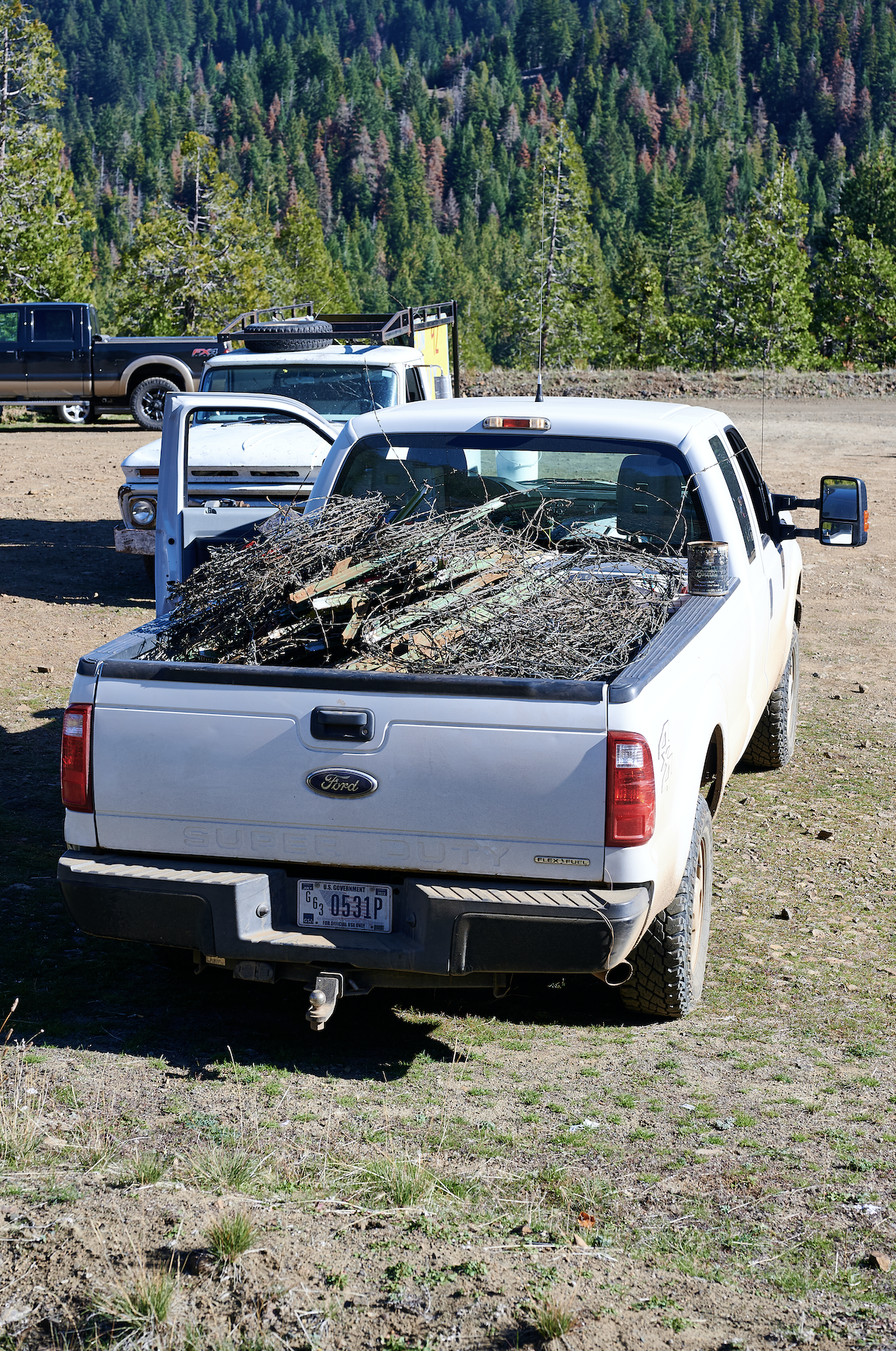
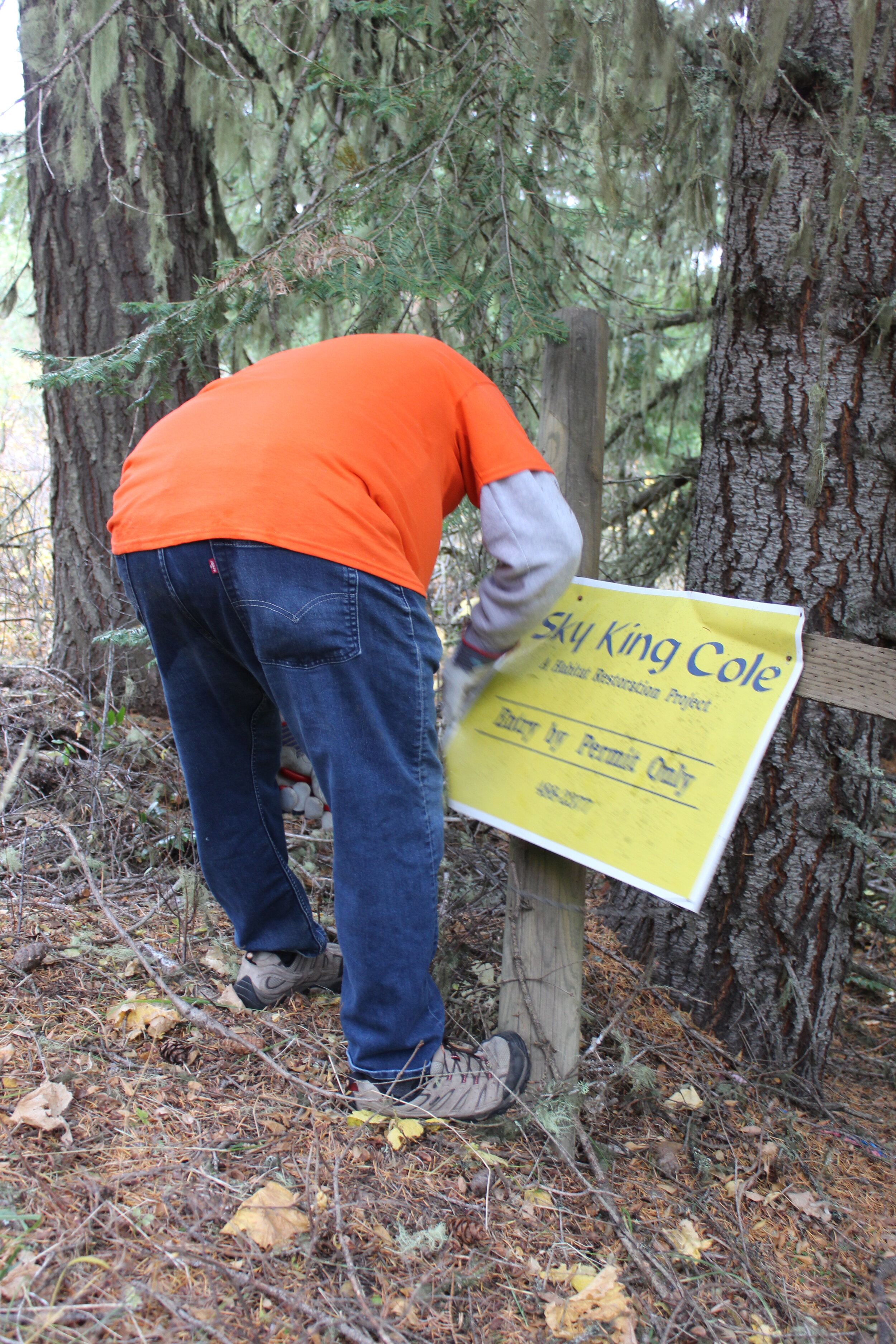
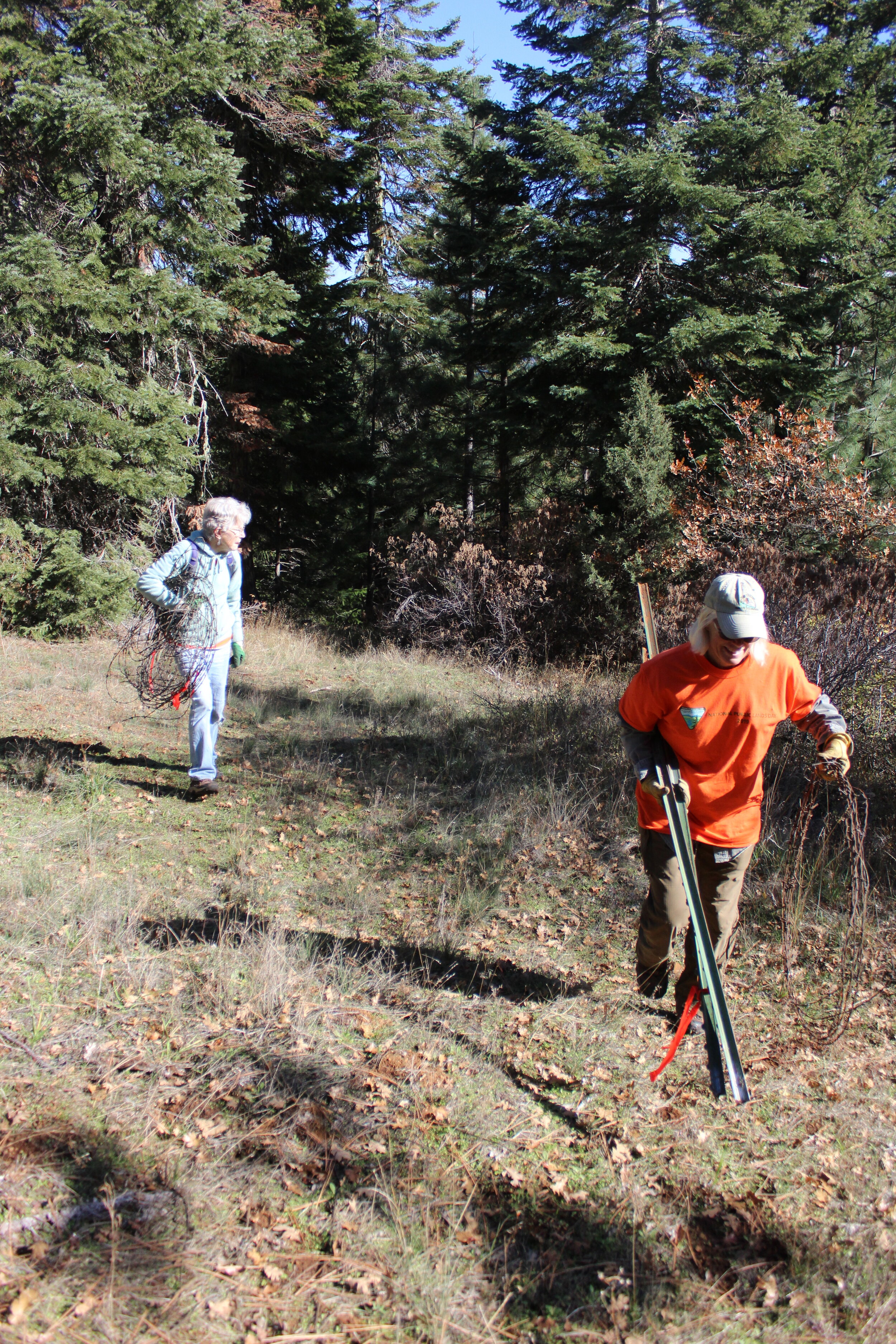
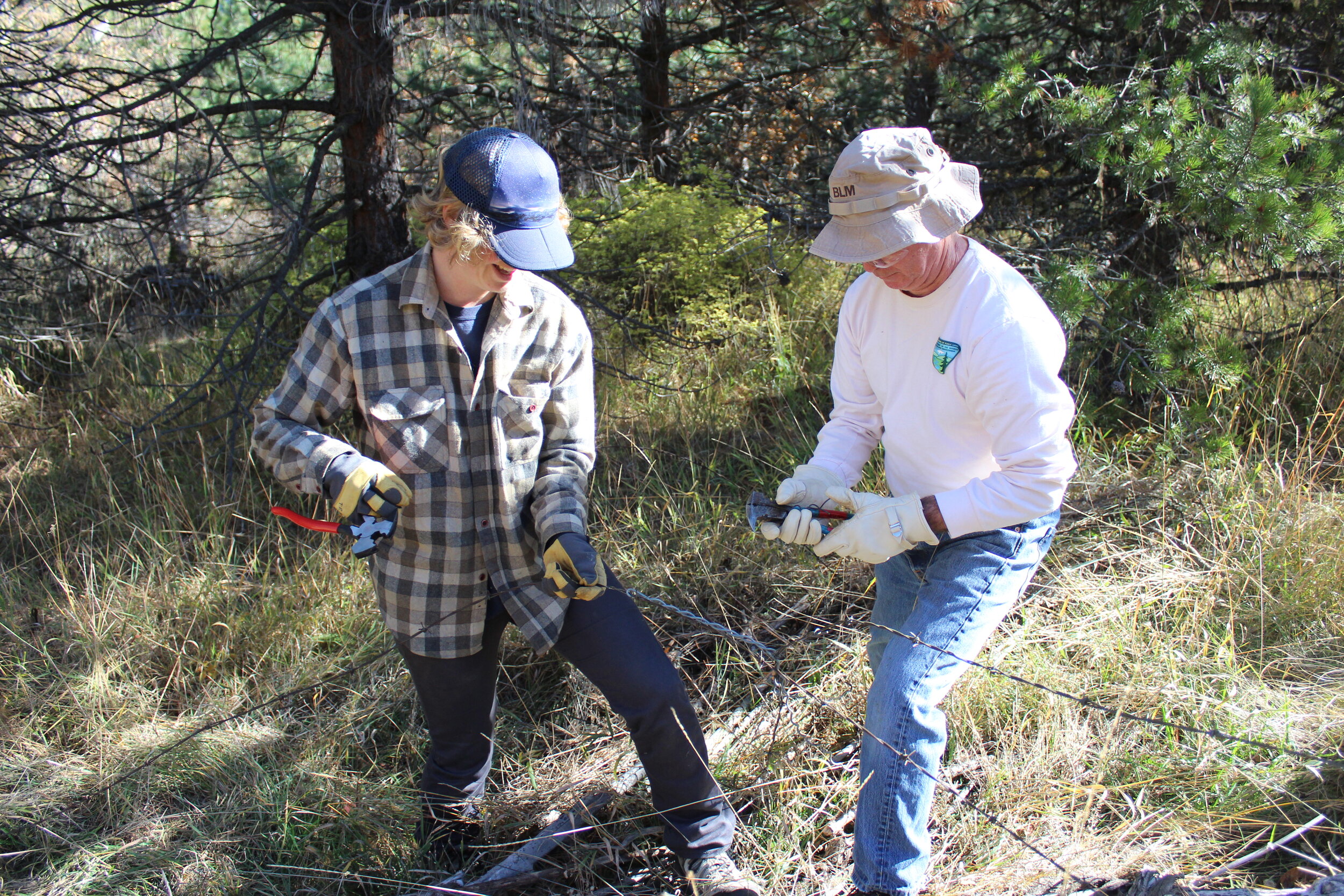
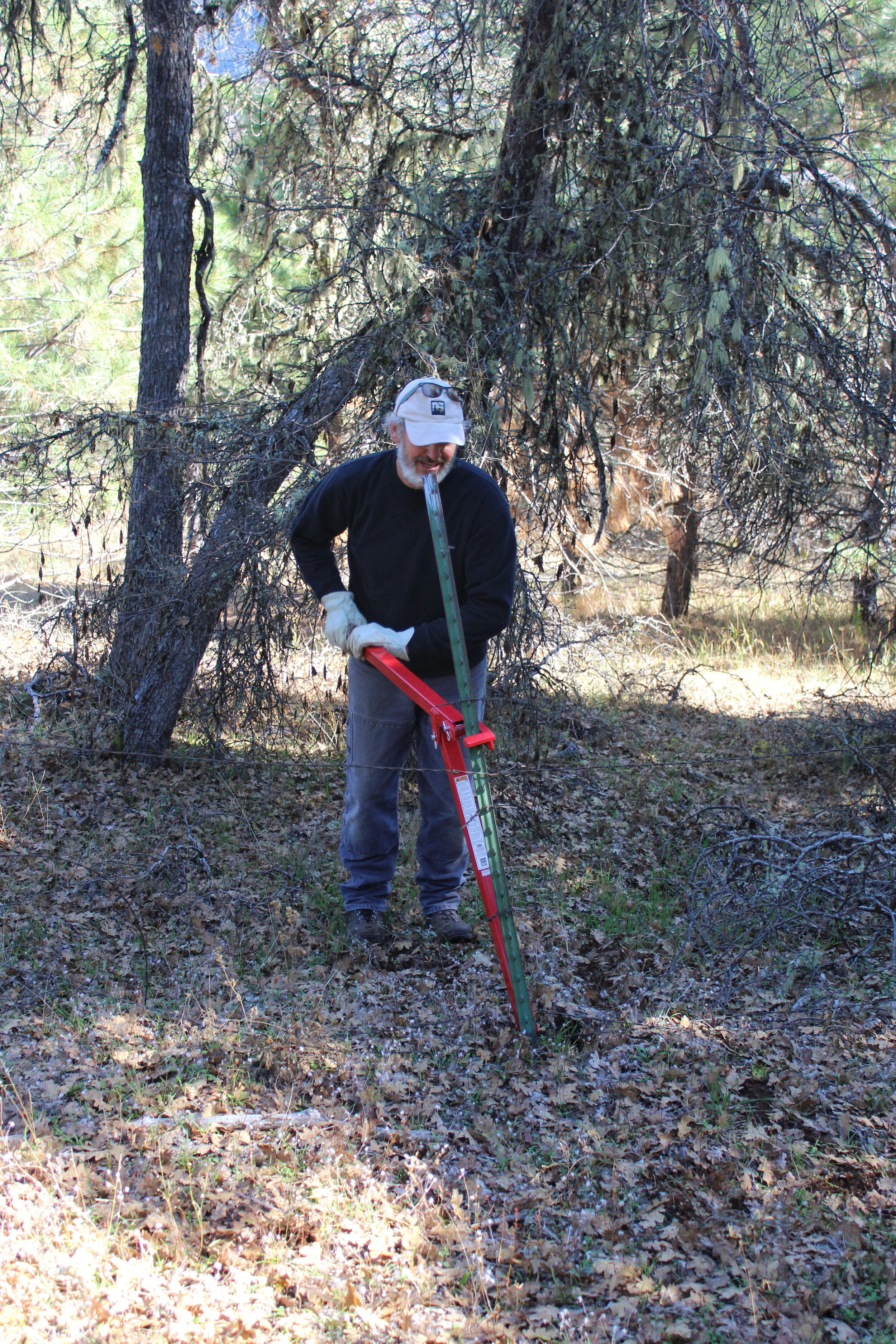
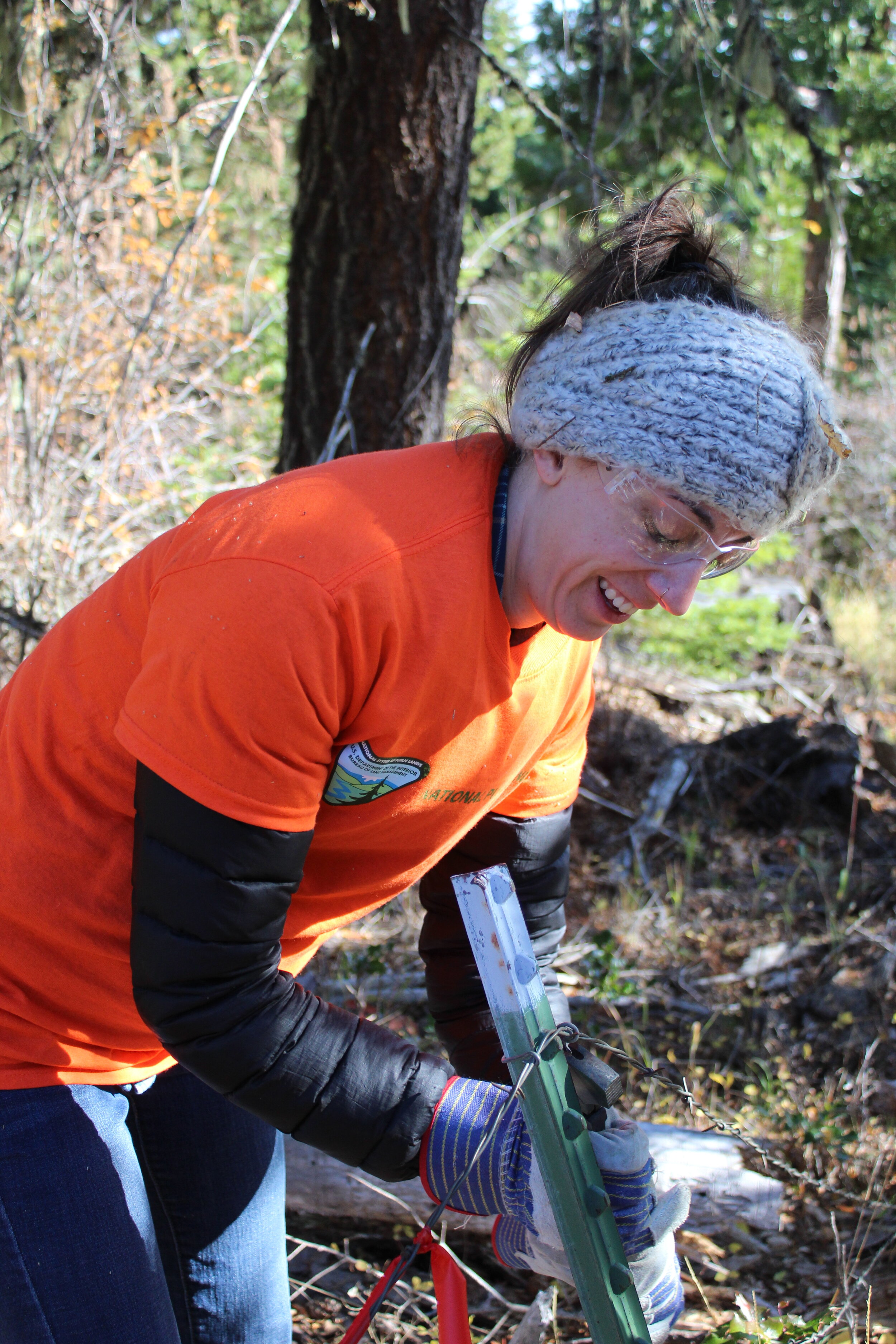
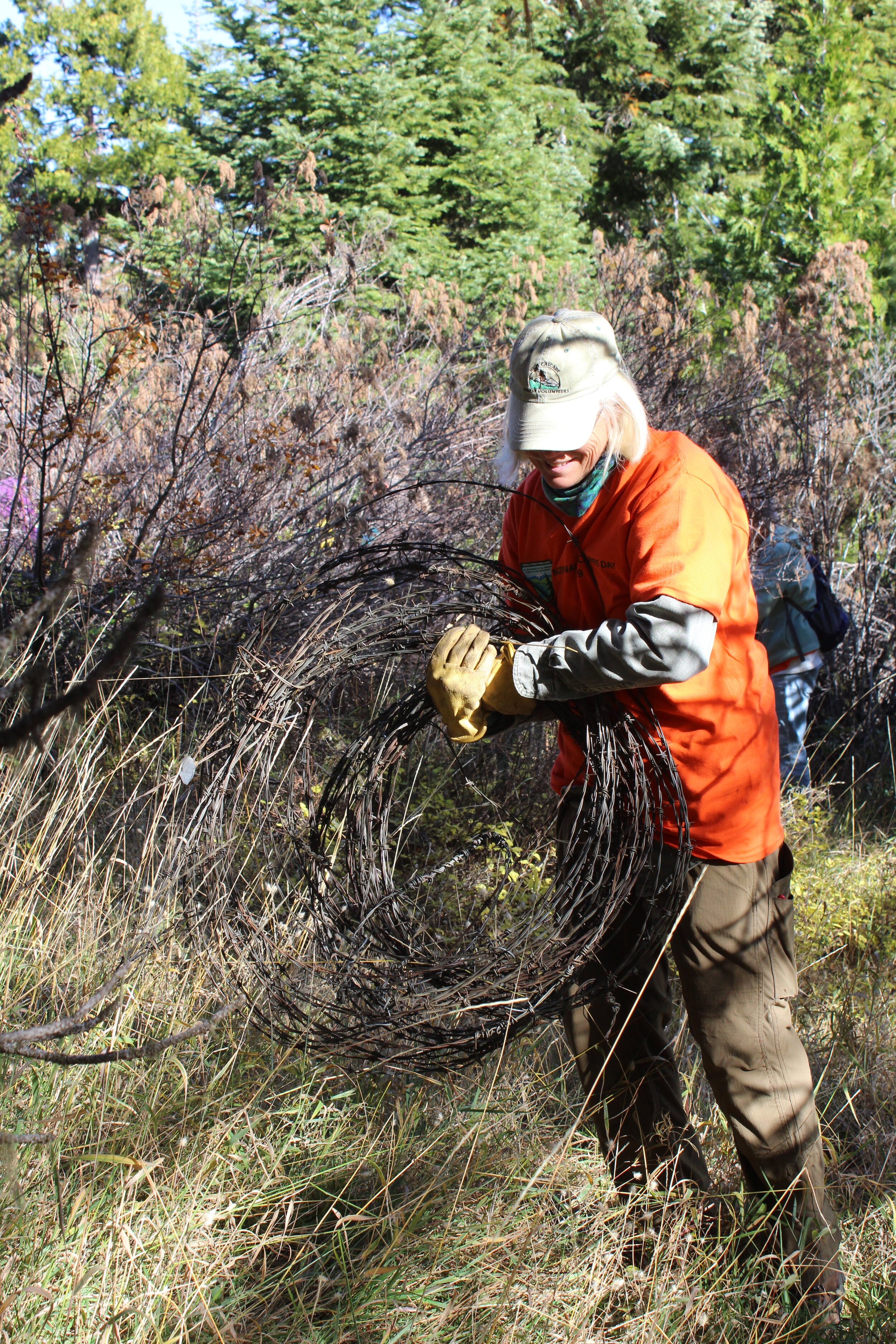
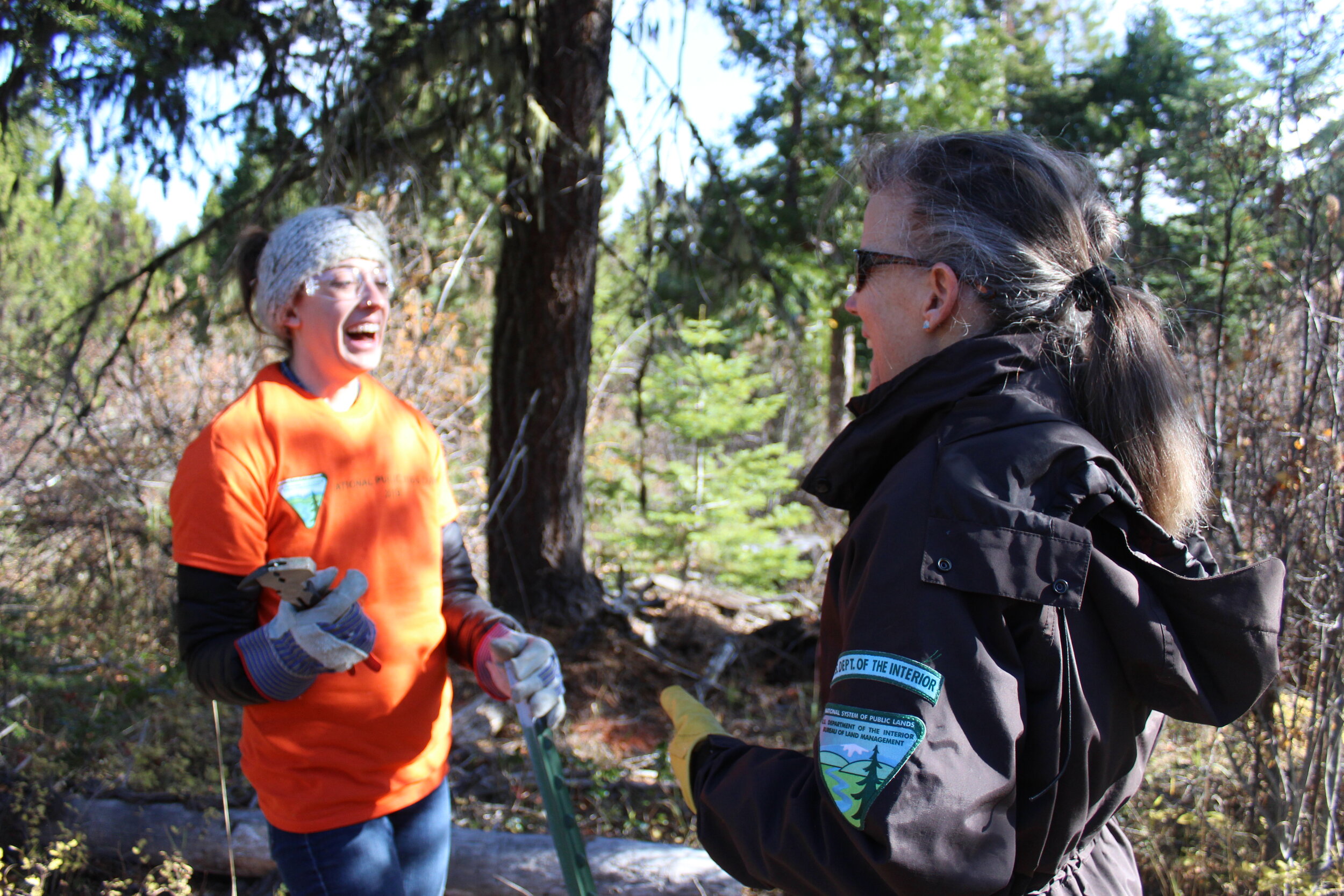
It is a Powerful Thing to Be Near Edges
As the temperature drops late in the year, less and less of us venture out into the mountains. In the forest, everything seems a bit more still, and most of the sounds around us come from the leaves crunching under our feet. But if you take a moment to stop and listen, there is still so much activity happening around us! When we think about what birds are doing this time of year, we tend to focus on all of the birds flying south and we often forget that we have feathered neighbors who stay here year-round. On October 11 and 12, the Friends of Cascade-Siskiyou National Monument discovered that you can encounter many birds in the Monument during the fall if you just take the time to listen and look. Klamath Bird Observatory board president, Shannon Rio, guided us on this quest during our final Hike & Learn of the 2019 season.
On Friday October 11, bird enthusiasts and eager learners gathered at the Geos Institute to hear Shannon speak about the birds you can listen and look for in the fall here in our region. These birds include great gray owls, dippers, yellow rumped warblers, bald eagles, pileated woodpeckers, flickers, white-breasted, red-breasted and pygmy nuthatches, golden-crowned and ruby-crowned kinglets, mountain chickadees, western bluebirds, Stellar’s jays, and of course Raven, the Trickster. She emphasized that the edges of distinct habitats are where the action is. In the Cascade-Siskiyou National Monument, the landscape is filled with a mosaic of edges: ridgelines tracing the tops of mountain ranges with vastly different plant communities on either side, edges of forests bordering open meadows, and edges of lakes, streams and rivers dividing aquatic and terrestrial habitats. “It is a powerful thing to be near edges”, Shannon told us.
On Saturday October 12, we had an opportunity to walk along these edges and look and listen for the Monument’s fall residents. We walked five miles along the Pacific Crest Trail, from Highway 66 at the Greensprings summit to the peaceful shores of Little Hyatt Reservoir, then returned to the highway by walking three miles along Old Hyatt Prairie Road. On our journey, we passed through forested areas, meadows and oak woodlands, identifying the birds we encountered and observing their behavior and interactions with other species all along the way. In total, we identified 28 species of birds and witnessed many captivating moments between different species and individuals. Shannon encouraged us to watch how different birds were behaving and figure out what their behavior could tell us. At one point along the trail, we ran into a number of Stellar’s jays making a huge ruckus and then we spotted the bird that they were mobbing: a Cooper’s hawk hunkered down in a fir tree! You never know what exciting things you will encounter on a walk along the edges in the Cascade-Siskiyou National Monument!
- Written by Ellie Cosgrove, Program Coordinator of Friends of Cascade-Siskiyou National Monument
Photos by Ellie Cosgrove
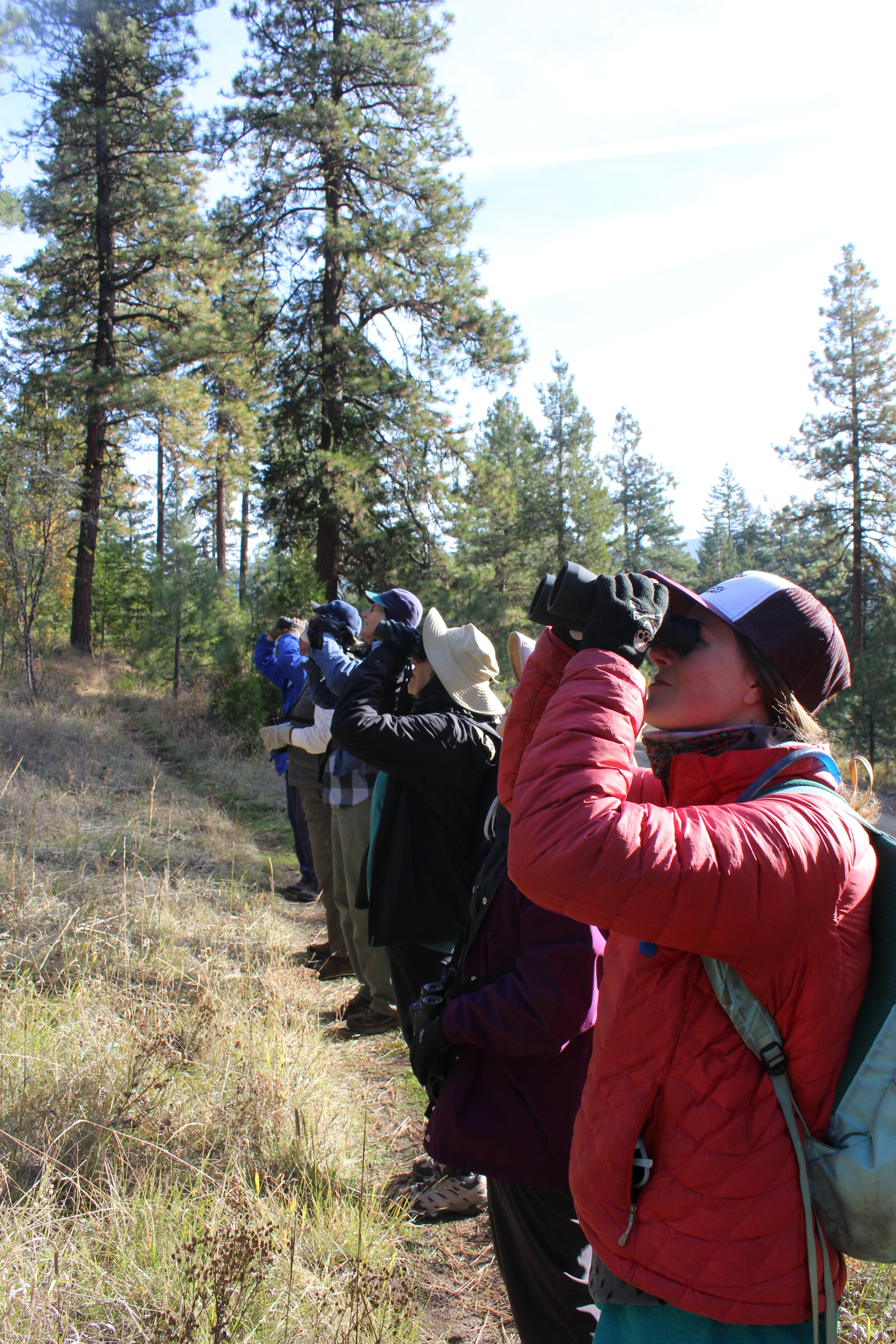
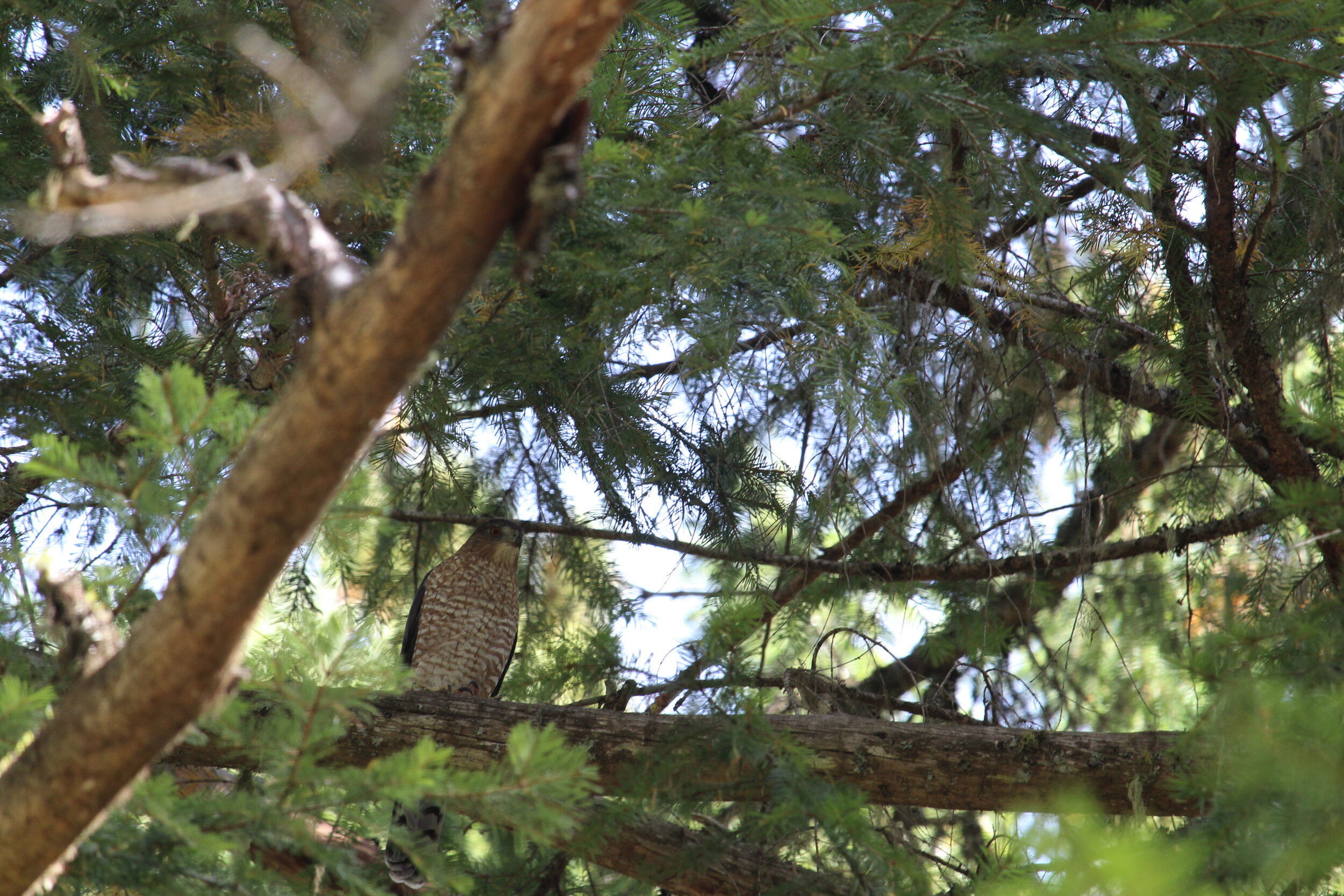
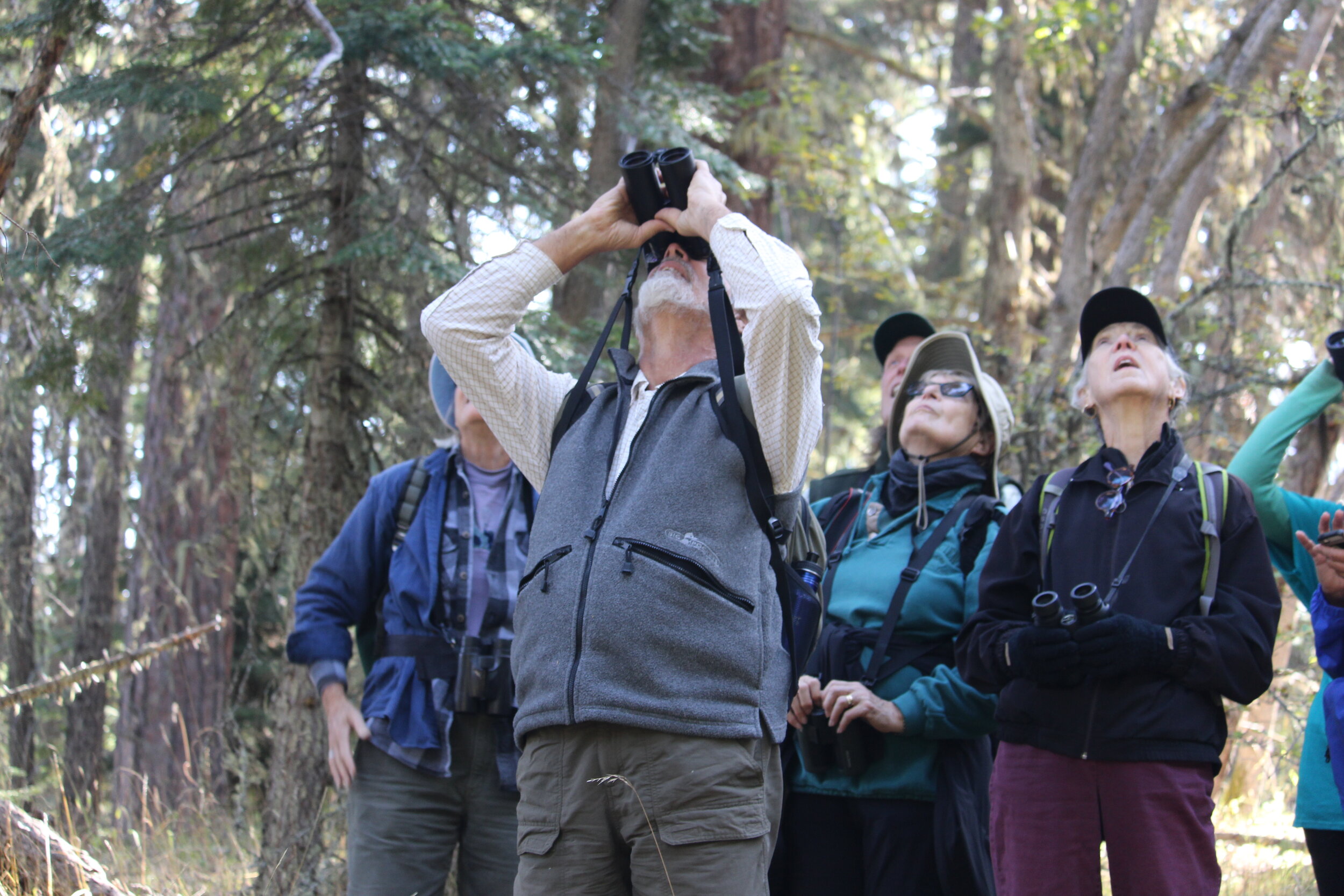
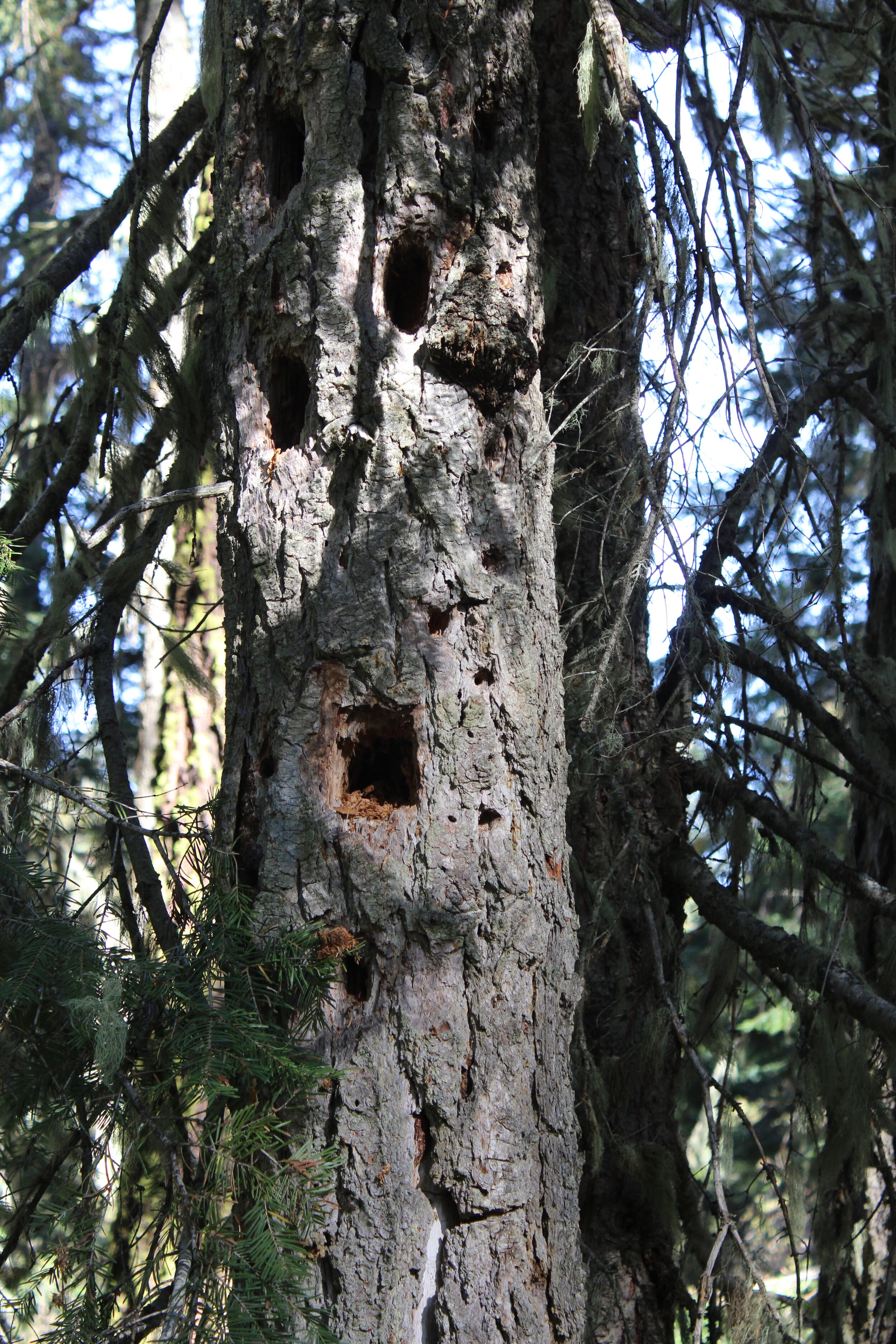
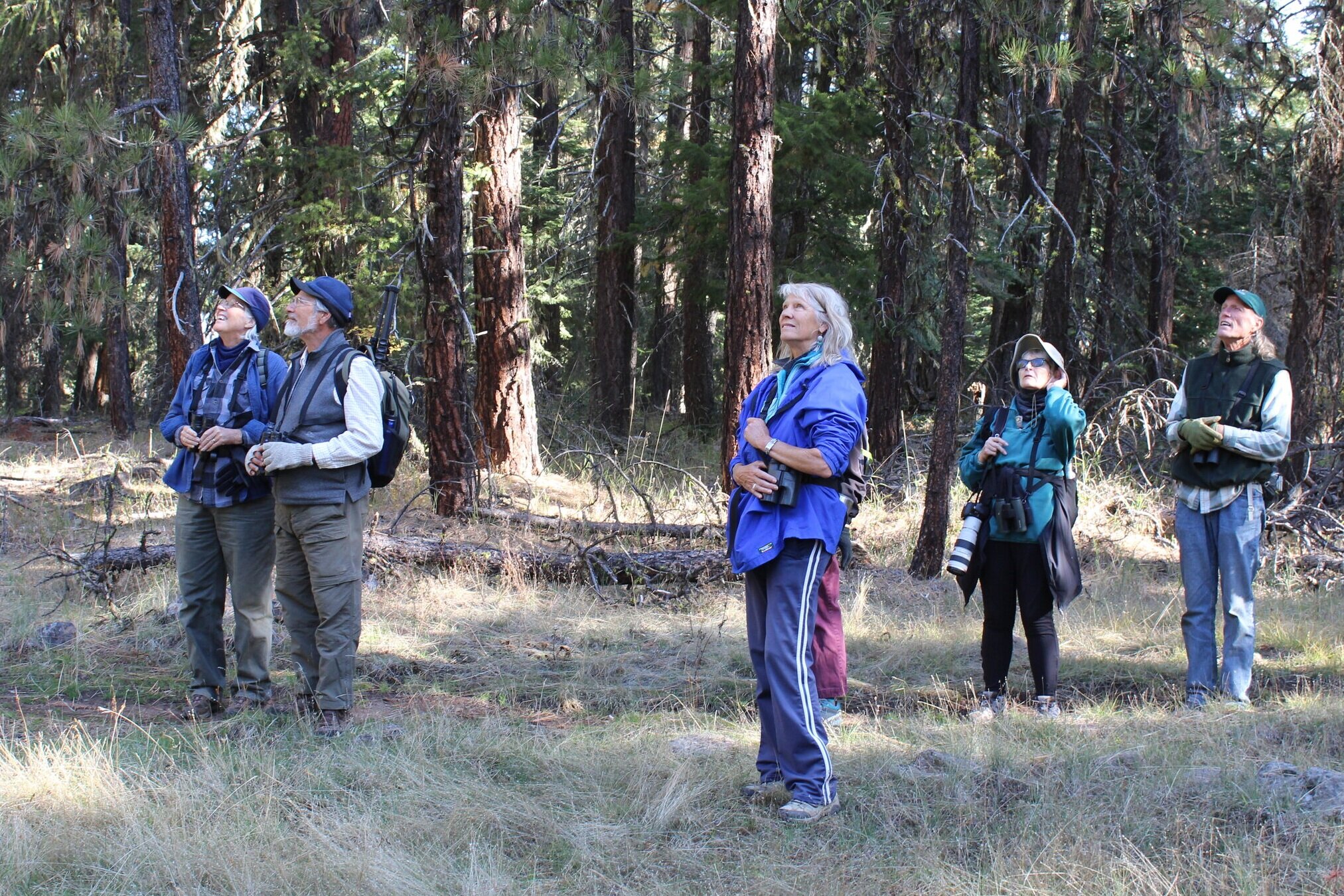
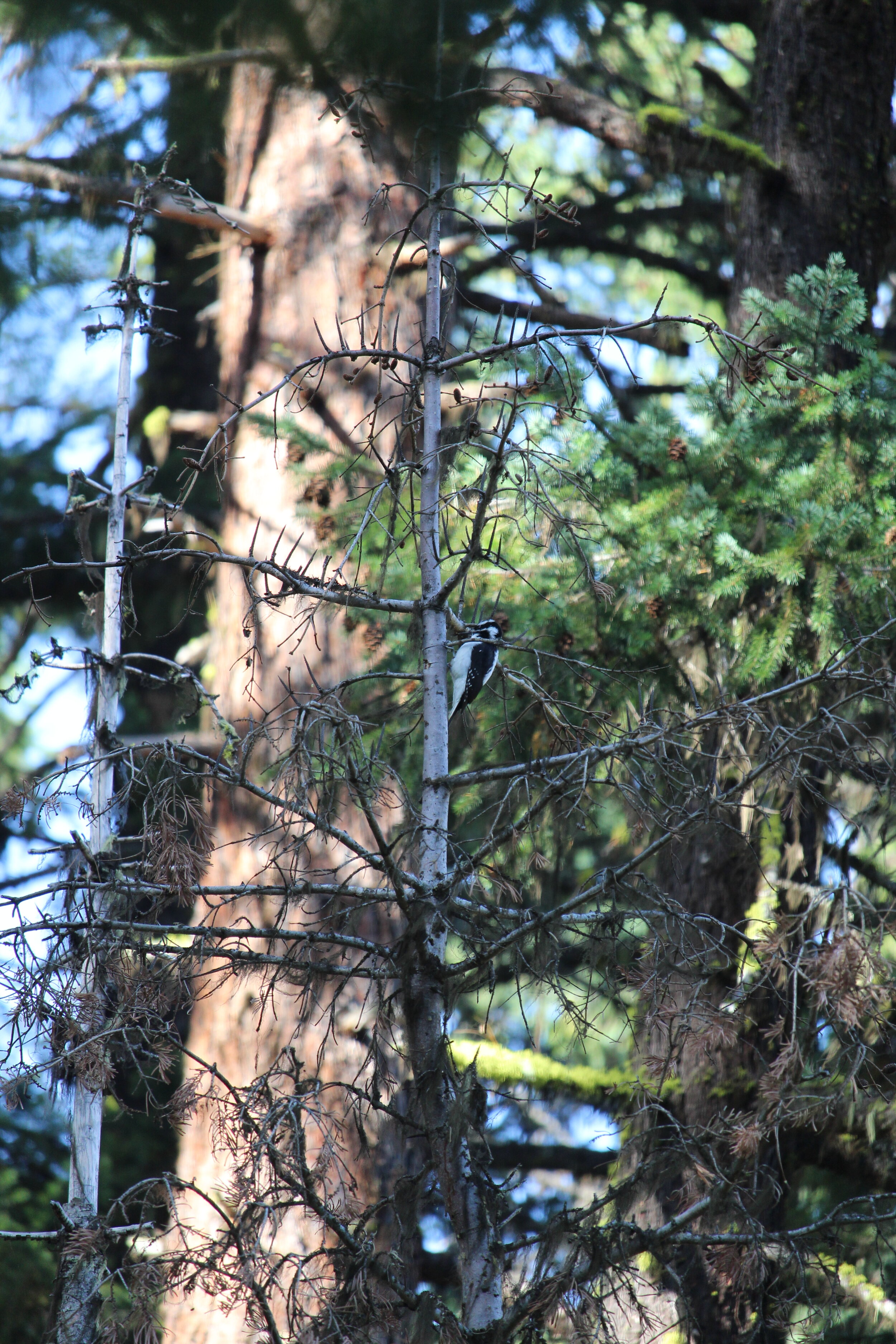
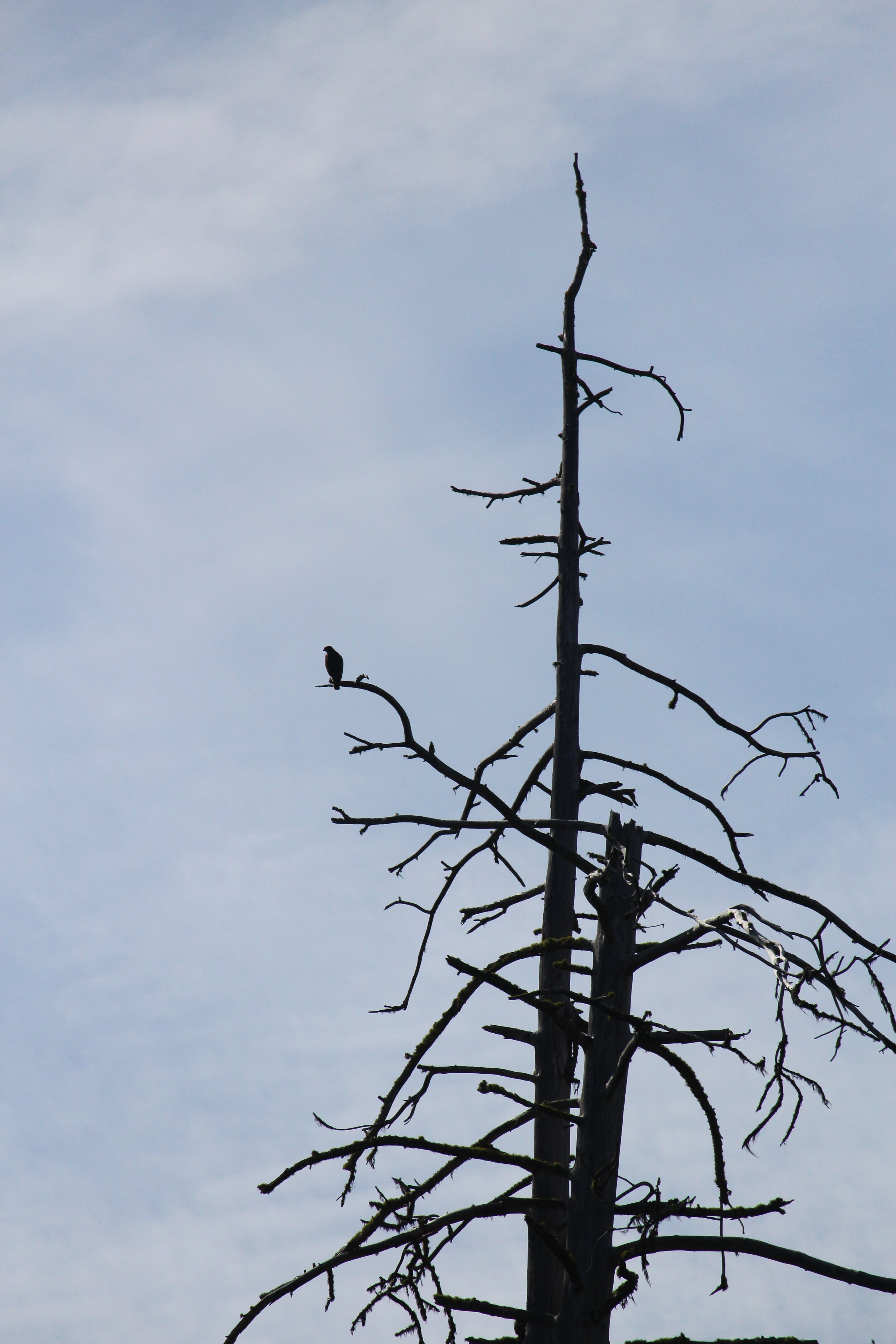
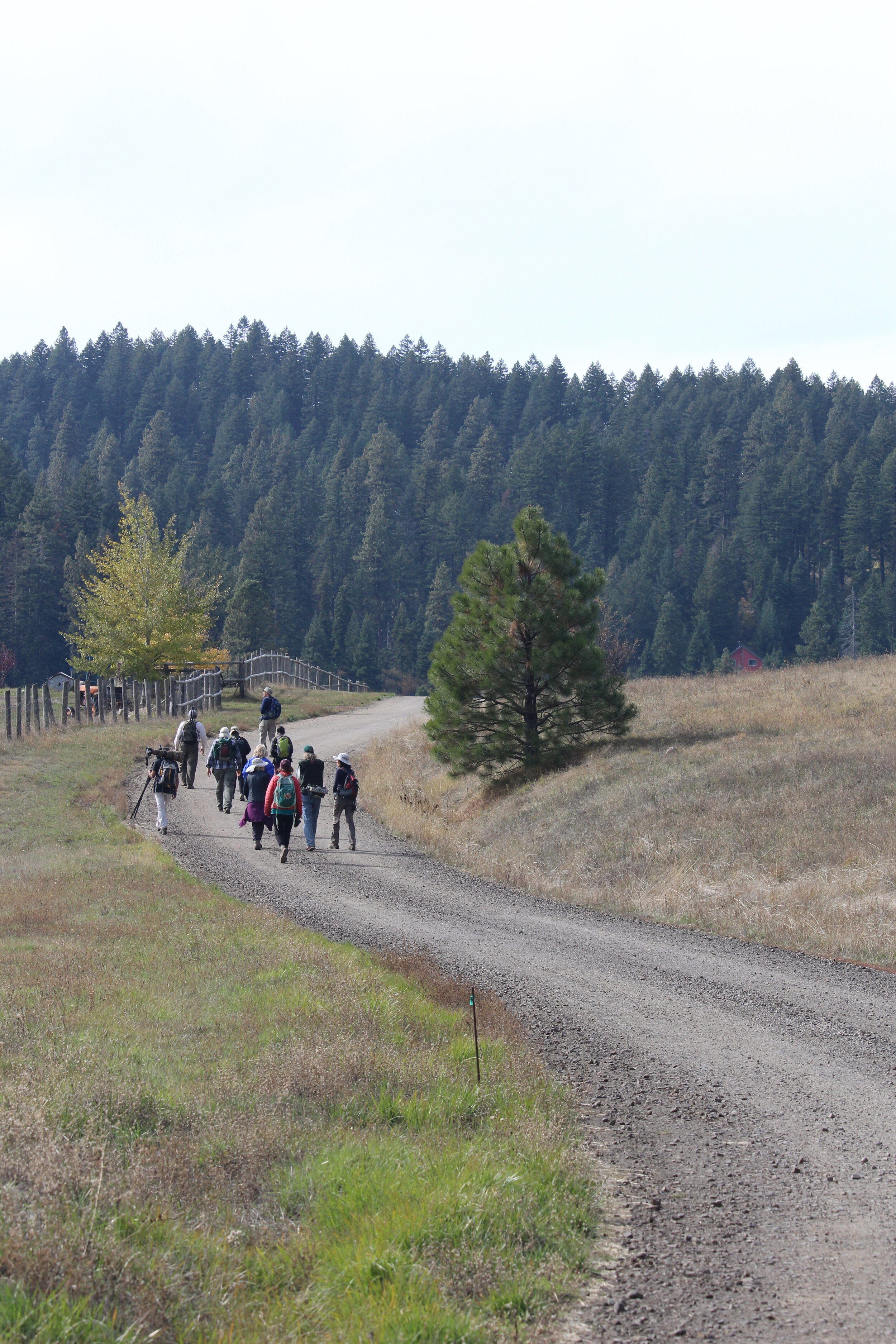
Citizen Science in Cascade-Siskiyou National Monument with Dr. Michael Parker
Turtles have a superpower. No, it’s not that they are all mutant ninjas, but they do seem to have the power to bring people of all ages together and fill them with excitement and awe. There’s nothing quite like the thrill of spotting a basking turtle on a log, no matter the age of the spotter.
At our September Hike & Learn event, the Friends of Cascade-Siskiyou National Monument teamed up with Dr. Michael Parker, aquatic biologist and professor at Southern Oregon University, to provide an opportunity for citizen scientists to meet our region’s only native turtle, the western pond turtle (Actinemys marmorata).
Populations of these turtles are currently under threat due to habitat alteration and loss from a variety of human caused factors, such as the building of dams and roads, the introduction of non-native species, pathogens and parasites, and removal from the wild for the pet trade.
The combination of these stressors, on top of the threat of climate change, has scientists worried about the future of this species. Currently the western pond turtle has been proposed for listing under the federal Endangered Species Act (ESA) and is federally designated as a "Species of Concern." In the state of Oregon, they have been listed as "Sensitive" and have been designated as an "Oregon Conservation Strategy Species."
Dr. Parker is one of the scientists conducting monitoring efforts to track populations of western pond turtles throughout Southern Oregon. This data will be crucial evidence for present and future western pond turtle species conservation. Our September Hike & Learn program took us out into the field with Dr. Parker to learn more about his western pond turtle research and assist him with his data collection!
On Saturday September 7, Dr. Parker brought reptile enthusiasts and eager learners up to the pond at Willow-Witt Ranch, one of the sites in the Cascade-Siskiyou National Monument where he is conducting western pond turtle monitoring. The day before the hike, Dr. Parker put out a number of traps in the pond to lure in turtles of all ages and sizes. We were able to catch a total of 19 turtles in the traps, ranging from just a few years old to some that could be as old as 50!
Each turtle was weighed by our citizen-scientists and a number of measurements were recorded. These measurements included shell height, carapace (hard upper shell) length, plastron (bottom shell) length, and carapace width. Each turtle also had a photograph taken of its plastron, a way of “fingerprinting” individuals since no two plastrons look exactly alike.
Out of the 19 turtles we caught and collected data for, only seven had been caught in the past. We knew that from the coding system that scientists use to mark individuals, where different combinations of marginal scutes (scutes are the large “scales” on turtles) are notched with a file to represent a number (see photo below). Each individual that is caught is given a number and is tagged with these notches. Don’t worry, creating these notches doesn’t hurt the turtles! Each time that these individuals are caught, the same measurements are done to track their growth.
Marking individual turtles also helps scientists estimate the total population size. Dr. Parker informed us that since 12 out of 19 of our turtles had never been caught and marked before, it may be possible that this particular population at the pond at Willow-Witt could be as large as 100 individuals!
The population of western pond turtles up at the Willow-Witt Ranch are of particular interest to Dr. Parker’s study because it is currently the highest elevation that these turtles have been found, an elevation just below 5000 feet. Studying this population may give us a glimpse of how these turtles may adapt as climate change forces plants and animals to move to higher elevations and temperatures increase.
One mystery currently surrounding this particular population of turtles is: Where do they go in the winter when it snows and the pond freezes over? Dr. Parker informed us that this fall he will be attaching radio transmitters to individual turtles living up at Willow-Witt to see where they go and what they do during the annual heavy snowfall at that high elevation. Stay tuned for his results!
There are so many questions to be answered and so many mysteries yet to uncover in the Cascade-Siskiyou National Monument. We hope that you continue to join us as we team up with local scientists to learn more about their research in this special place!
- Written by Ellie Cosgrove, Program Coordinator of Friends of Cascade-Siskiyou National Monument
Photos by Ellie Cosgrove
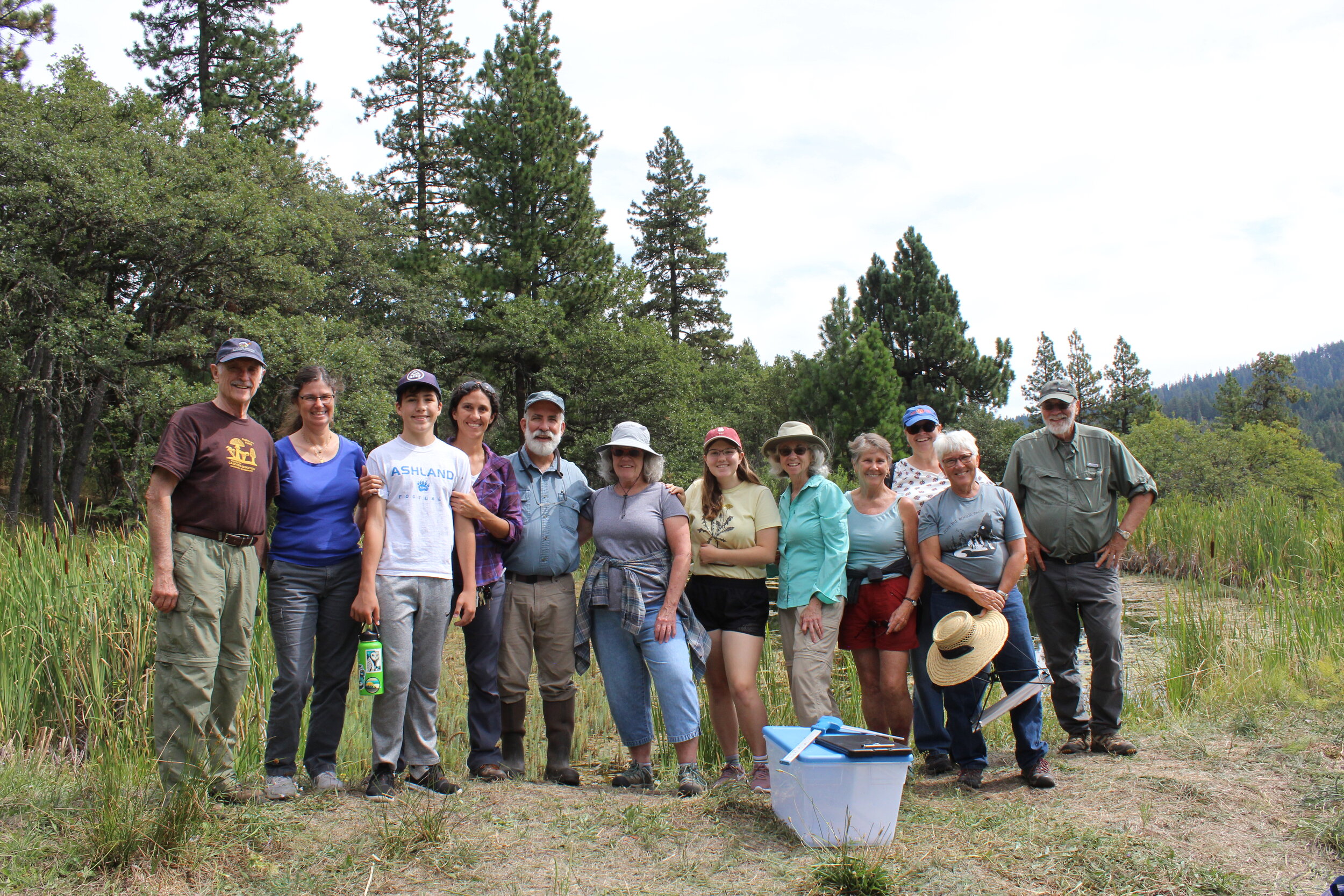
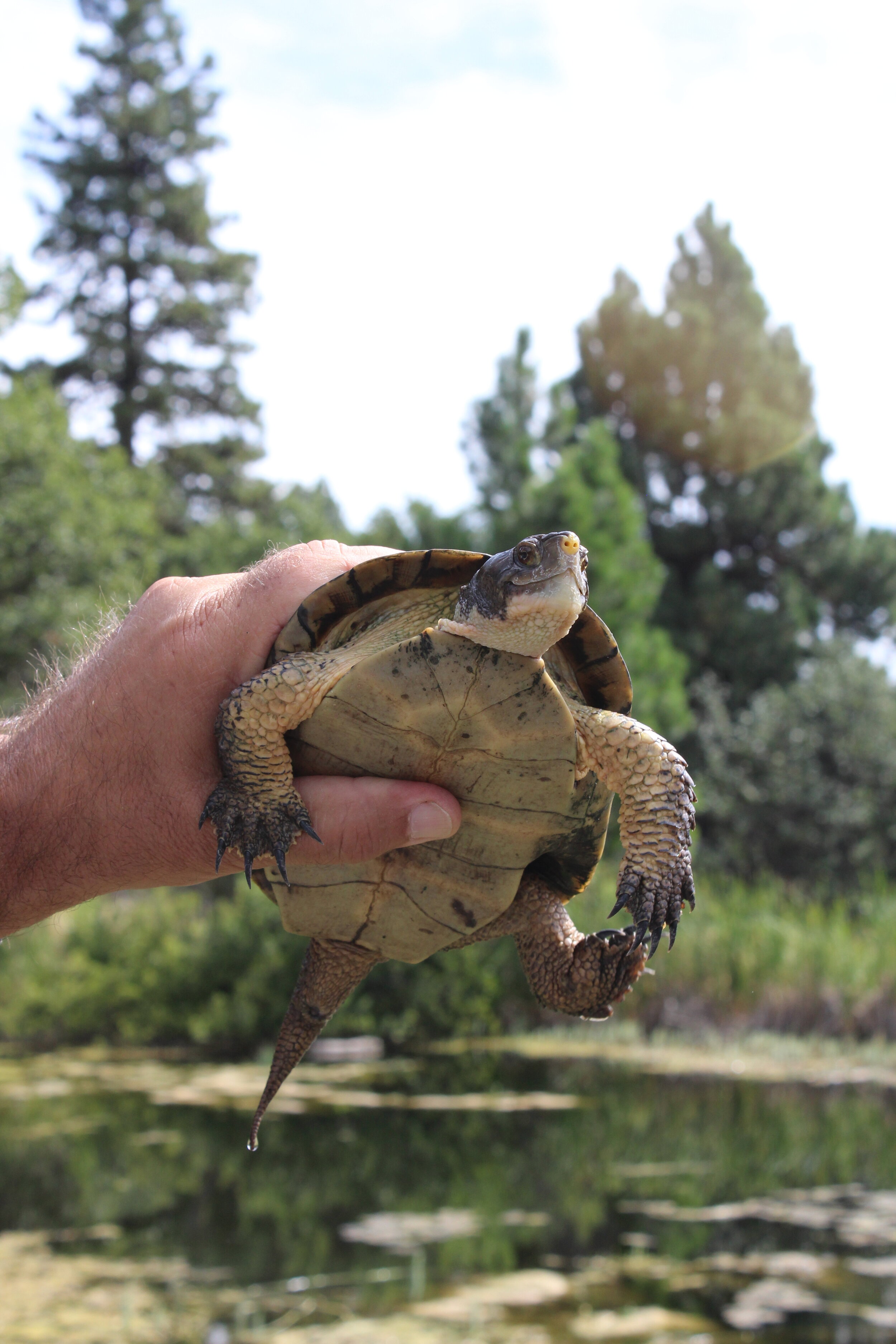
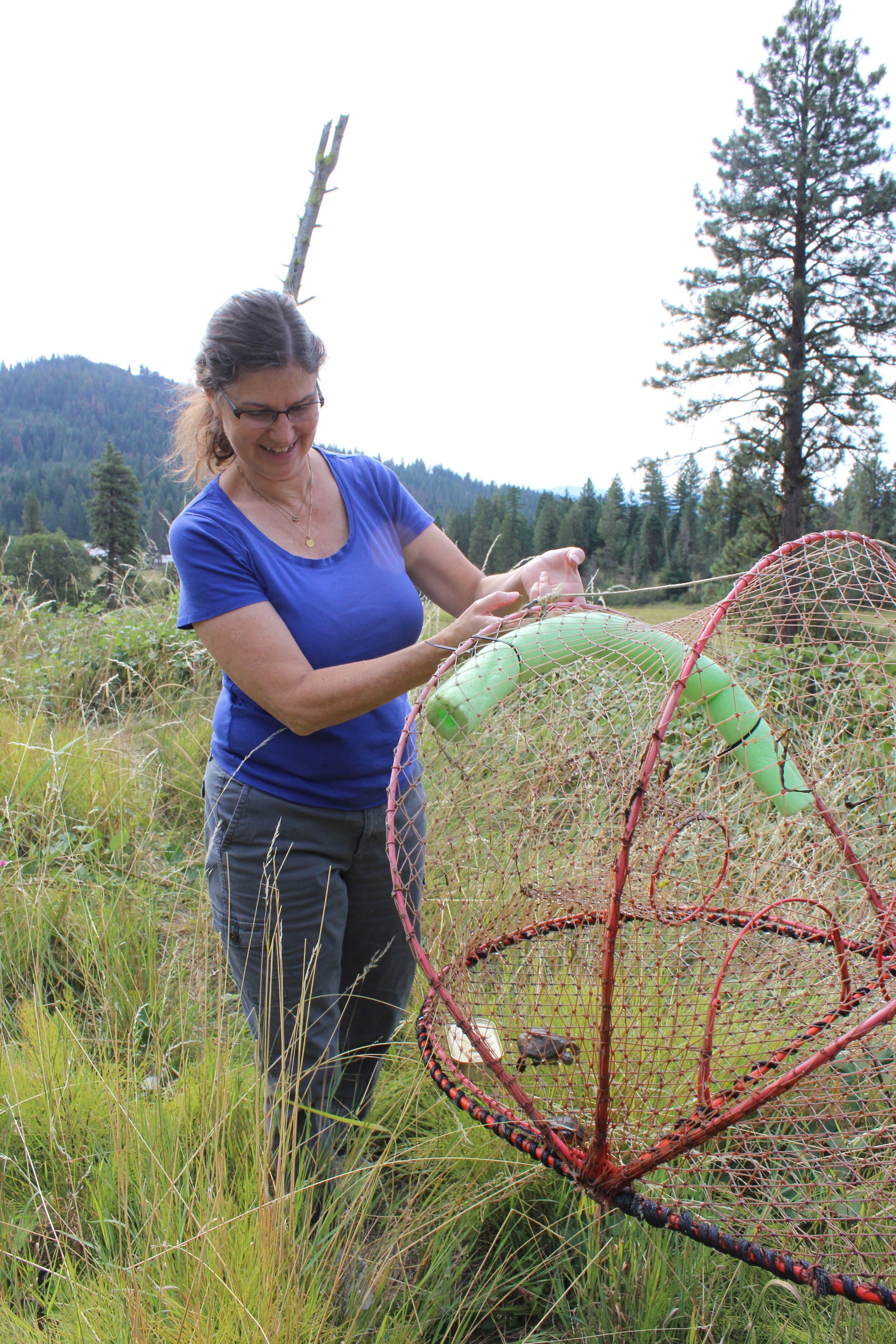
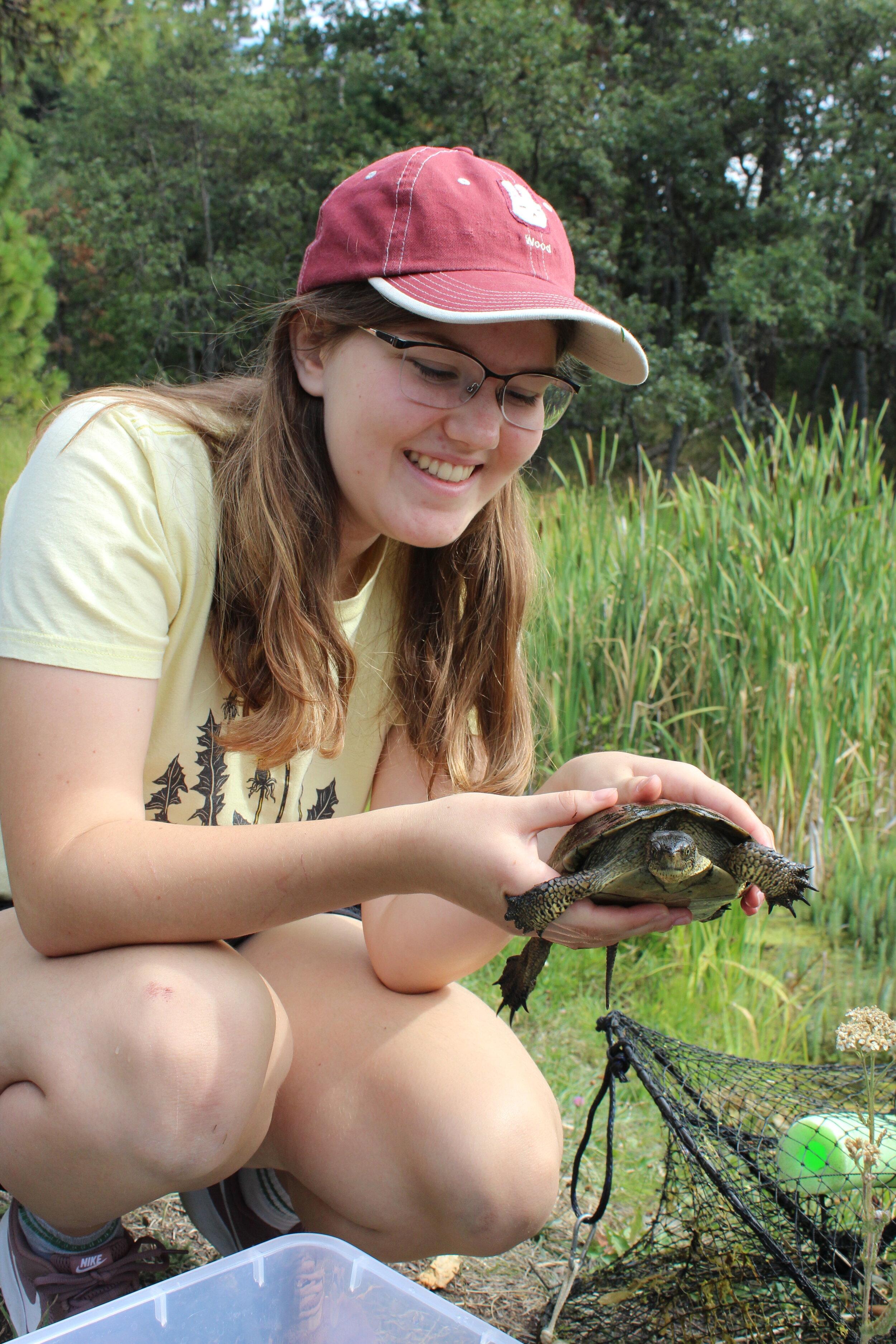
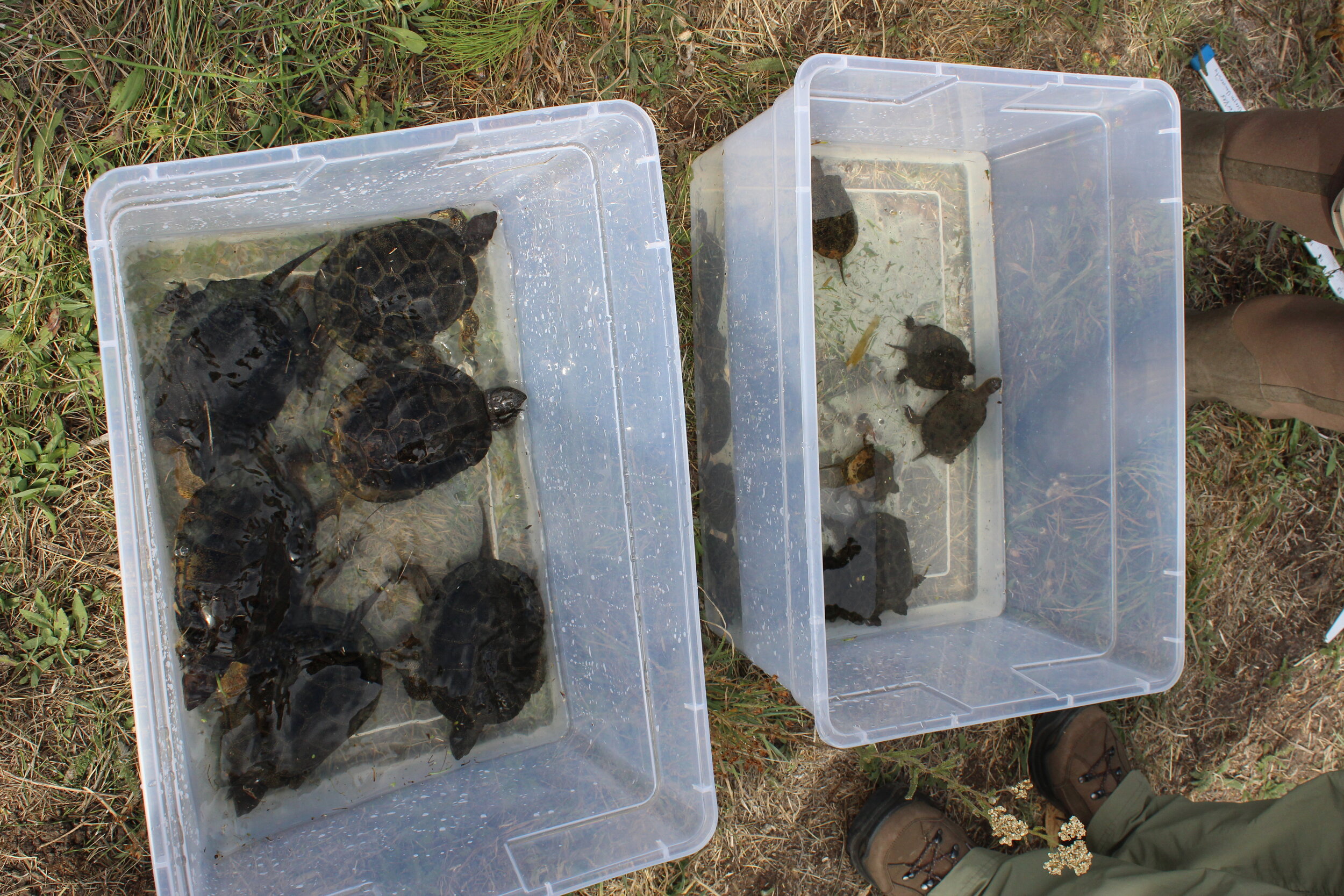
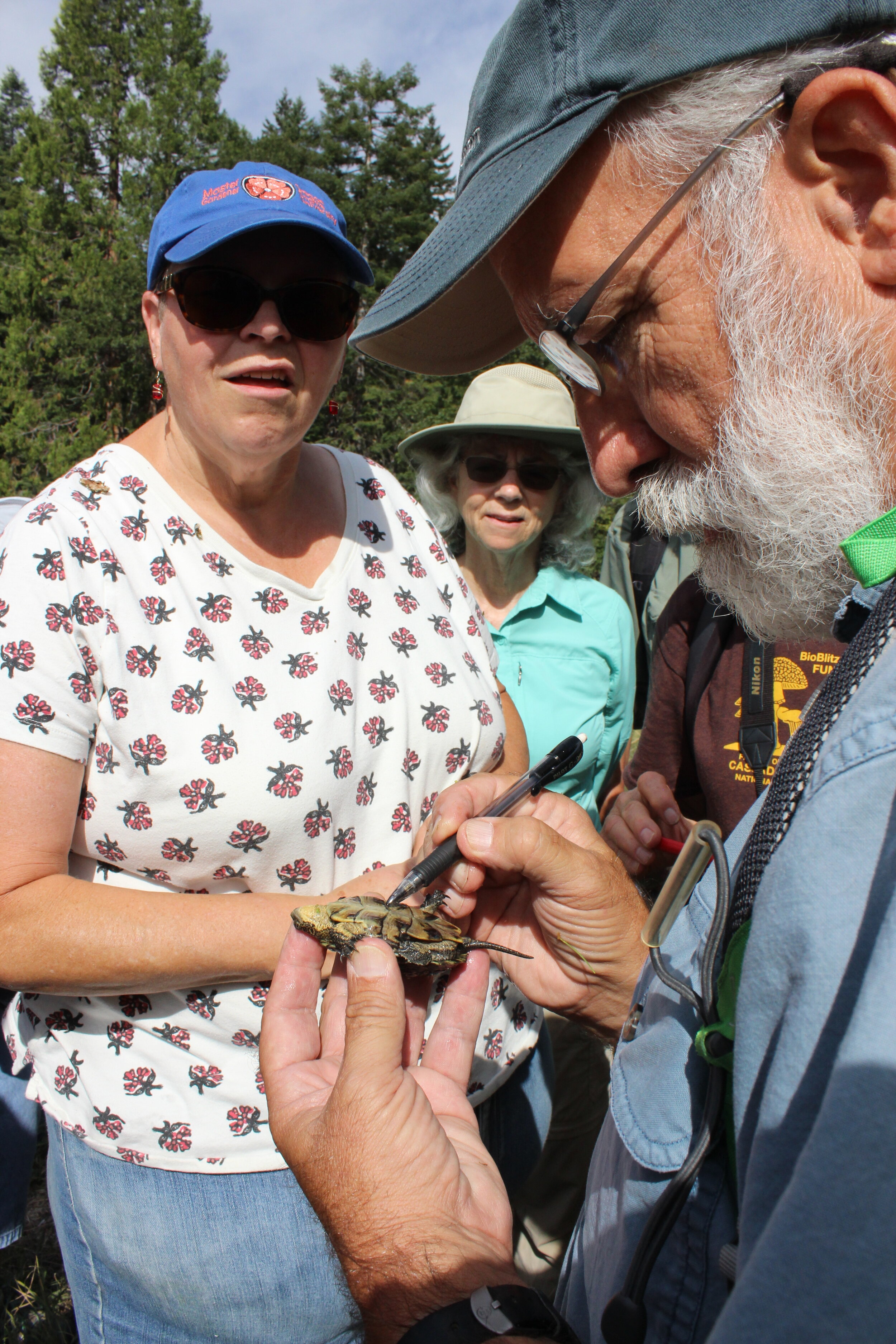
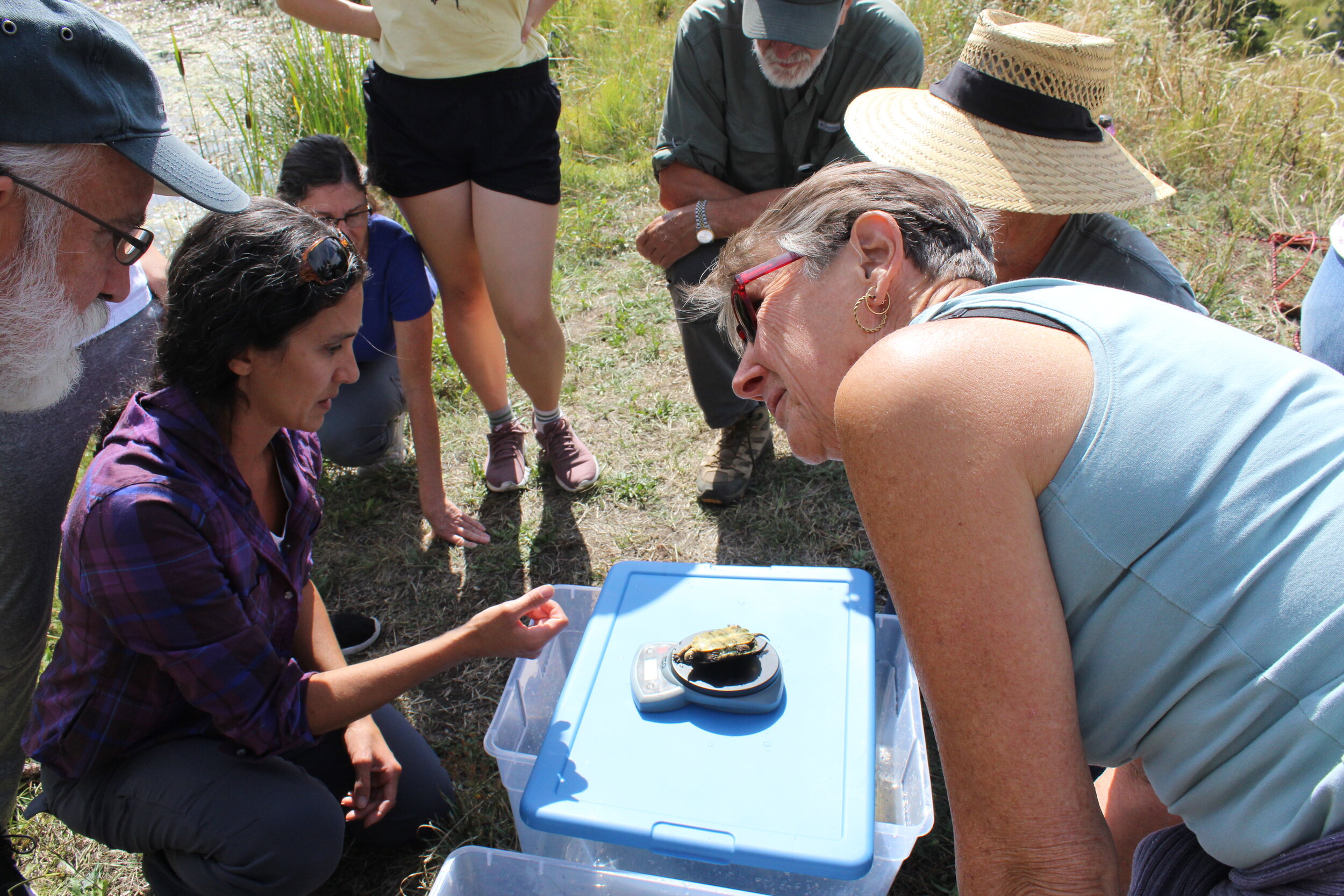
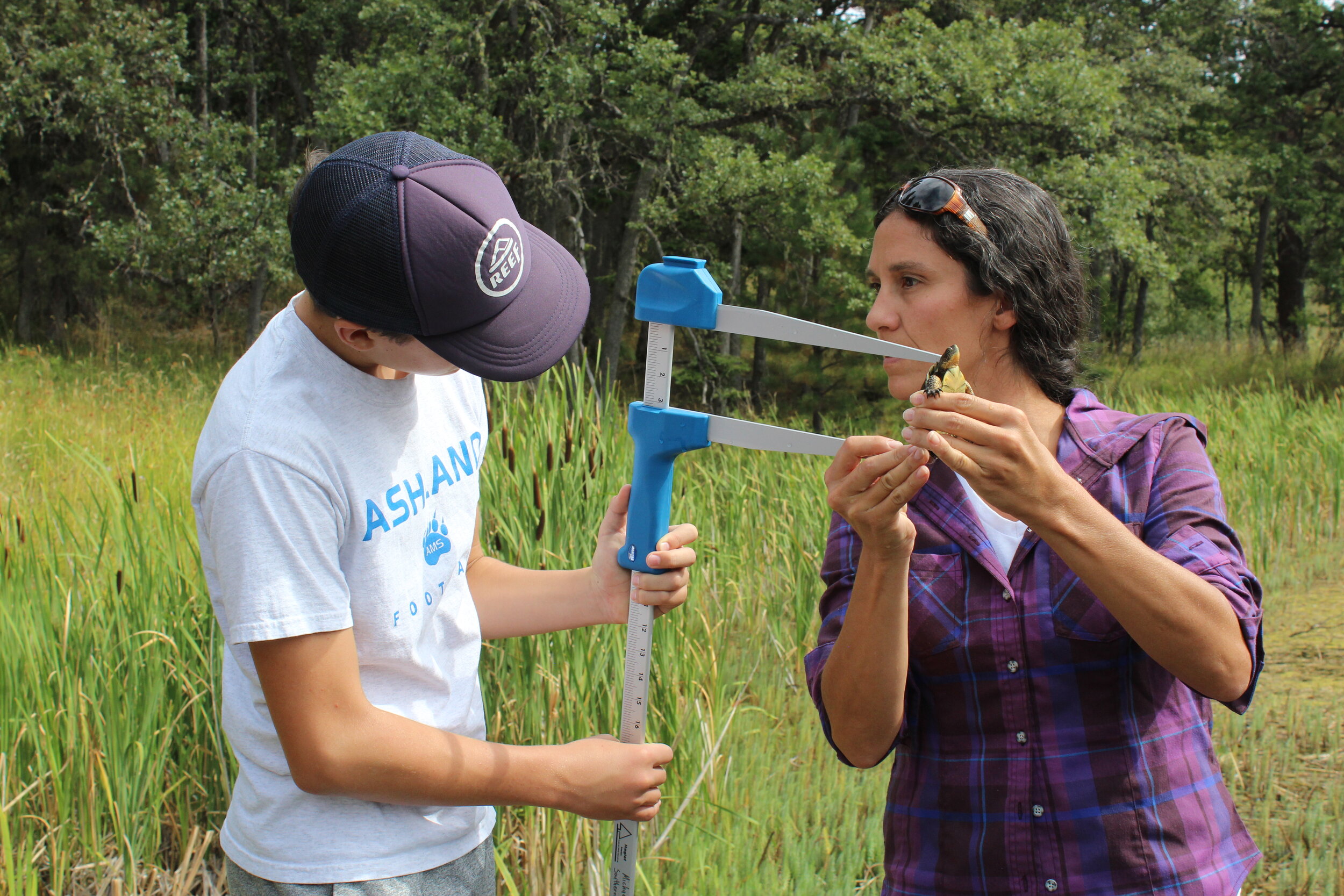
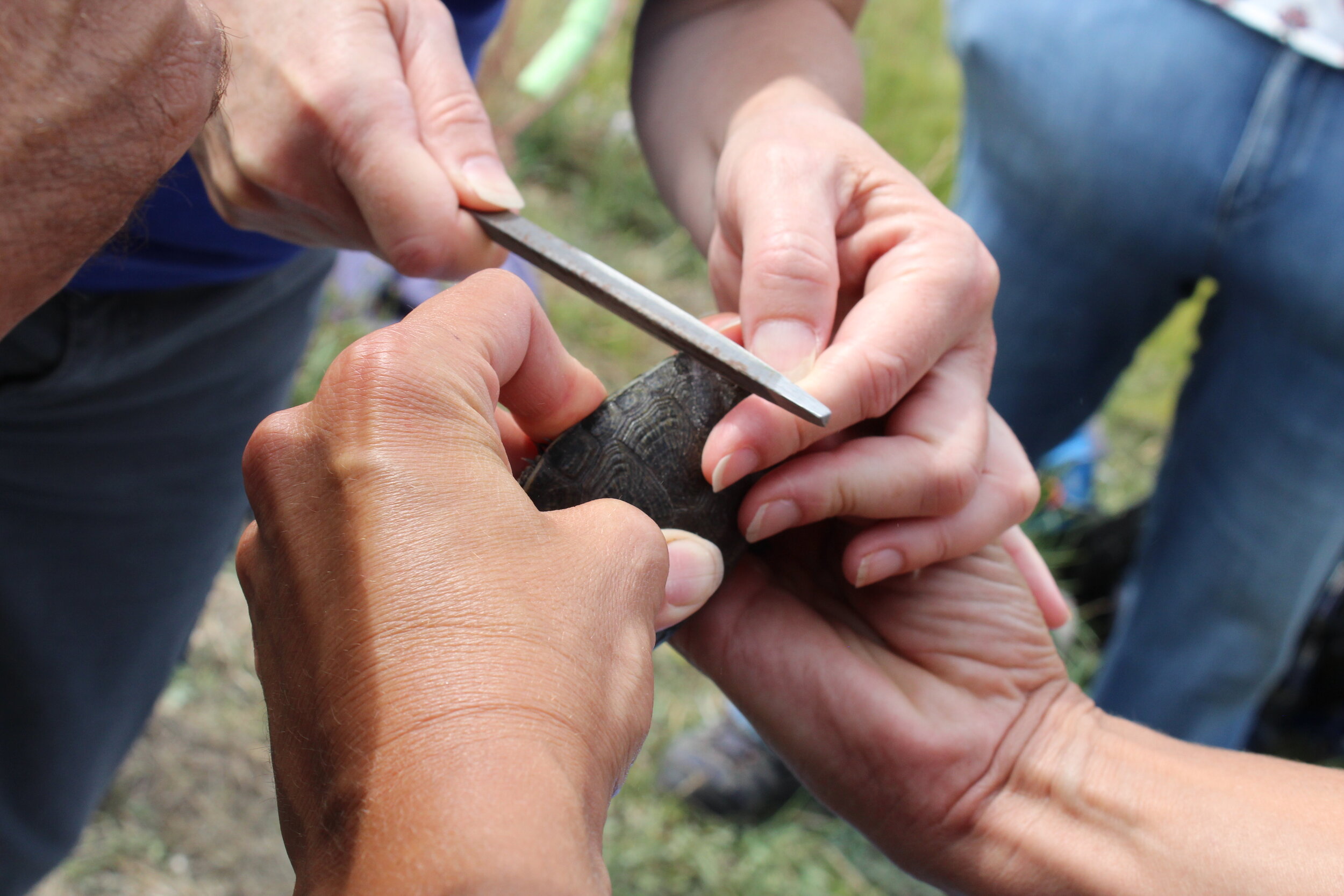

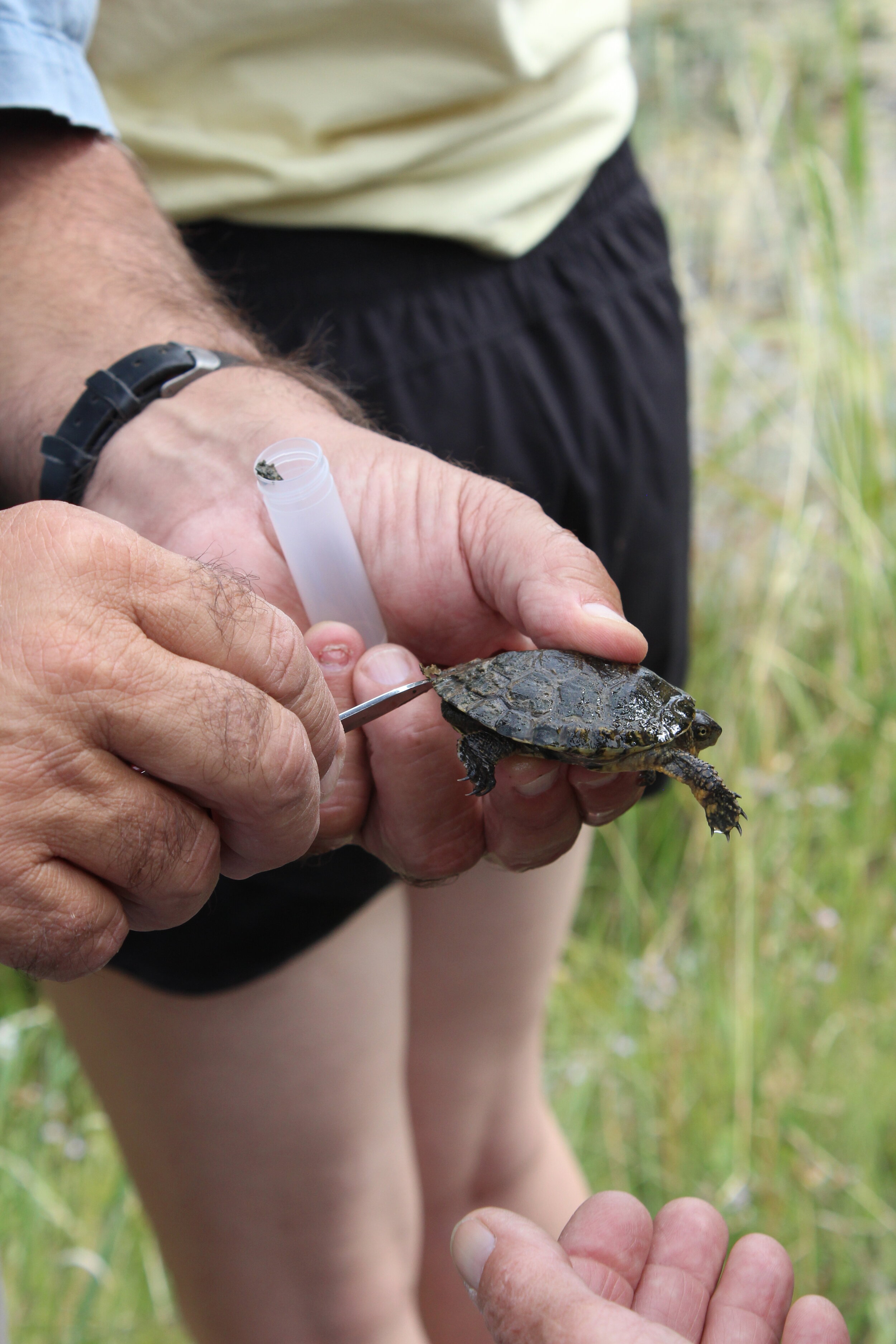
Hike Recap: Meditation and Mindfulness in the Monument
By Stasie Maxwell
When you walk into the woods, how often is it to observe or learn about yourself? With a National Monument that is home to over 3,500 species, including birds, butterflies and an amazing diversity of conifers (just to name a few), your own self may not have been on the list of things to observe. On May 25, it was.
While our Hike and Learns are usually organized with the scientific lens of ecology or botany in mind, this one was led through the lens of biomechanics therapy, specifically Qigong and meditation. Biomechanics is the study of human motion and is utilized in determining what caused injuries and how we may prevent them in the future. Qigong is between 4-5,000 years old and is a system of breathing practices and movement therapy geared towards rejuvenation and regeneration.
As we all probably know already, walking into the woods has an immediate anxiety reducing effect. Meditating in a sunny meadow, surrounded by trees and wildflowers can only deepen those relaxing qualities for the body and mind. I, Stasie Maxwell, am a long-time student and practitioner of Qigong and meditation. While we can learn much about the many plants, birds and animals, they also have much to teach us about ourselves. As I led the participants through both seated, standing and movement meditation (Qigong) I shared my favorite relational exercise.
I invited everyone to choose a plant, or animal somewhere in the meadow and observe the characteristics of that plant. I used vetch as an example; the plant spreads easily and quickly, it has many little tendrils to reach out and climb up or out. We can interpret this as an outgoing, opportunistic plant. It spreads its tendrils out in many directions searching for every opportunity. I can then relate those traits to myself. I am more of an introverted person, not outgoing, but I can see when the traits of being outgoing are beneficial. In terms of opportunistic, there is a strategy in feeling out many opportunities and moving in the direction that works best for you.
As you walk through the woods the next time, observe the various traits of the plants and animals, consider if you possess those traits yourself, or if you’d like to, or if there are situations where you could utilize those observed traits. There are lessons all around us, and opportunities for rejuvenation.




Launching the Grassland Restoration Research Project
Friends of Cascade-Siskiyou National Monument teamed up with KS Wild and the Bureau of Land Management for the 5th Annual Weed Pull at the Mariposa Lily Botanical Area in the Monument on June 17. This area is a very important section of the Monument because it provides crucial habitat for the rare Green’s Mariposa Lily (Calochortus greenei).
Much of this area has a long history of heavy grazing which has drastically changed the plant communities from native bunchgrasses and wildflowers to mostly non-native grasses and flowering plants, such as yellow starthistle (Centaurea solstitialis) and medusahead grass (Taeniatherum caput-medusae).
This year’s weed pull was a little bit different because it also served as the kickoff for the Grassland Restoration Research Project in the botanical area. Participants worked alongside Charles Schelz, the Monument ecologist, to create two 5m x 20m plots in the botanical area. In each of the two plots, four 5m x 5m subplots were created to test out different methods of removing non-native plant species and encouraging native plants to grow in their absence.
One of the four subplots served as the control, so no treatment was done in those subplots. In the second subplot, no weeding was done at all, but the area was seeded with a mix of native plant species. In the third subplot, light weeding was done in patches and the area was seeded with the same seed mix, and in the fourth and final subplot, volunteers manually pulled out all of the non-native species and the area was seeded.
One year from now, we will start a monitoring project that will give us a better idea of what the best method is to remove non-native plant species in this area. Will it be seeding only? Light weed pulling and seeding? Or pulling everything and seeding with native species? Keep your eye on our future newsletters for opportunities to take part in this monitoring effort!
Ellie Thompson, Program Coordinator

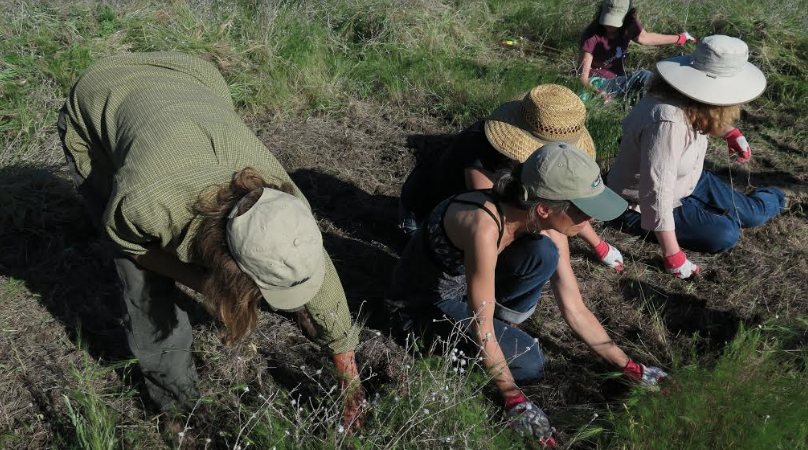
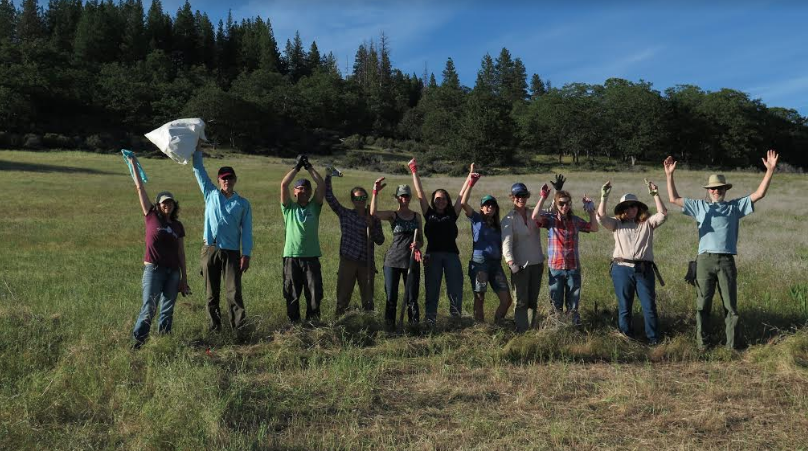
Hike Recap: More than Morels with Bashira Muhammad
There’s nothing like the excitement you experience when you come across a delectable-looking mushroom on a walk in the woods, or even discovering one in your backyard! In Southern Oregon, the mushroom that seems to be on everyone’s minds is the elusive but delicious morel. But before your mouth starts watering too much… can you explain what a mushroom is, and how it is different from a plant?
On Saturday, April 6, the Friends of Cascade-Siskiyou National Monument, KS Wild, and the Siskiyou Chapter of the Native Plant Society of Oregon teamed up to offer a hike for mushroom enthusiasts to learn the answers to these questions, and to see what types of fungi we could find living in the Cascade-Siskiyou National Monument. Guess what? We found More than Morels!
Bashira Muhammad is a mushroom farmer and the founder of Zoom Out Mycology, a local company based in Ashland that helps people grow mushrooms and teaches fungi-centric environmental education programs. As our guide, she encouraged us from the beginning of the hike to resist the urge to harvest the things that we found, and instead take this opportunity to make observations and see what we could learn from them. We were also encouraged to think about our impact on the landscape during our hike, and how we could be good stewards of the land during our visit. One example of this is replacing the logs that we rolled over in search of fungi.
This hike took many of us to a part of the Cascade-Siskiyou National Monument that we had never been before: an area off of Emigrant Creek Road, just north of Buck Rock. On our hike, we traversed between multiple different habitat types with varying microclimates: warm, open oak savannas and cooler, mixed woodlands with more conifers and lots of shade. In the more open, warm oak savanna, we discovered bird’s nest fungi, a member of the Nidulariaceae family. This fungus gets its name from the tiny fruiting bodies that resemble eggs inside a bird’s nest.
In the mixed woodland, we came across another exciting find: a false morel! False morels are members of the genera Gyromitra and Verpa, not to be confused with true morels, which compose the genus Morchella. We learned that true morels have hollow stipes (stipes are the “stem” of the mushroom), while false morels have stipes that are filled with fibers or chunks of tissue. False morels contain a toxin that if ingested, can lead to illness and even death. Bashira impressed upon the group the importance of not harvesting or eating anything if we aren’t sure it is an edible mushroom.
After making careful observations of each mushroom we found, we were able to deduce that mushrooms are not members of the plant kingdom, but are instead a member of the kingdom Fungi. The two main differences between fungi and plants are 1) fungi cell walls are composed of chitin (the same material that makes up insect exoskeletons!), while plant cell walls are composed of cellulose, and 2) fungi do not make their own food using photosynthesis. Instead, a fungus gets its food from non-living organic matter, breaking it down and releasing nutrients back into the soil.
While we did not end up finding any true morels on our hike, we discovered a huge diversity of fungus among us. In addition to the false morels and bird’s nest fungi, we found turkey tail, puffballs, jellies, cup fungi, and a few gilled mushrooms. The diversity of fungi that we found in such a short time got us thinking: What mushrooms would we find if we returned next week or next month? And how many more species of fungi call the monument home? There is so much more exploring to be done!
“More than Morels” was the first of a series of spring hikes planned collaboratively between KS Wild, the Friends of Cascade-Siskiyou National Monument, and the Siskiyou Chapter of the Native Plant Society of Oregon. Join us as we continue to chase the wildflowers through the elevations in our backyard monument! For more information about the next two hikes in this series, visit KS Wild's calendar of events.
- Written by Ellie Thompson, Program Coordinator of Friends of Cascade-Siskiyou National Monument
Photos by Ellie Thompson
2019 Monument Research Symposium
By Nicole Ferer, Friends of CSNM Student Board Member.
What do American pika, the Oregon Vesper sparrow and the Western Cascades have in common? They all were student research projects conducted in our wonderful Monument, supported by the Friends of the Cascade-Siskiyou National Monument. For the past three years, the Friends have hosted the Monument Research Symposium, highlighting research projects ranging from dragonflies to great grey owls. The event provides a platform for scientific research communication where community members, students and Monument-enthusiasts alike can learn about current research being conducted in the Monument.
This year at the Monument Research Symposium we were fortunate enough to have four knowledgeable and enthusiastic student researchers, all recipients of the Friends Research Fund, whose passion for their field research, specific projects, and the Monument as a whole was infectious for the entire audience.
Emily Lind SOU, MS Environmental Education
Morphology and vocalizations of the Oregon Vesper sparrow subspecies in and around the Cascade-Siskiyou National Monument. Dr. Stewart Janes, SOU Professor of Biology / Director of Environmental Education, served as faculty advisor.
The Oregon Vesper sparrow subspecies is currently being petitioned for listing under the Endangered Species Act. Emily and her research team collected feather samples for future genetic analysis, and morphological metrics (form and structure) for all birds captured. They also recorded vocalizations (calls and songs) from 25 individuals from the Rogue Basin, Willamette Valley, and Great Basin populations combined. All of this data will be helpful in determining subspecies distinctions between the Willamette Valley, Rogue Basin, and Great Basin Vesper Sparrow populations. The preliminary analysis of morphology shows that there are significant differences between the Willamette Valley and Rogue Basin Vesper sparrow populations.
Dylan Carlini University of Oregon, BS Geology
Geochemical analyzation and geologic mapping of the Western and High Cascades. Dr. Jad D’Allura, SOU Professor Emeritus, served as faculty advisor.
The interface between the Western and High Cascades is a particularly geologically interesting location and warrants much greater study. The goal of this research project was to contribute to a comprehensive geologic map of the CSNM in order to provide a better understanding of the history and genesis of the Monument. Dylan’s field research consisted of mapping and geochemically analyzing (determining the chemical compound) volcanic rock units of the Western and High Cascades using LiDAR data (surveying method that measures distance using lasers), topographic maps, and petrographic analysis. Dylan and his team were able to extend the range of the Western Cascade exposures by over half a kilometer into what was previously mapped as High Cascade materials.
Alec Bayarsky and Neil Clayton SOU, BS Environmental Science and Policy
Distribution of American Pika (Ochotona princeps) within the Cascade-Siskiyou National Monument. Dr. Jamie Trammell, SOU Professor of Environmental Science, served as faculty advisor.
While a population of American pika was recently discovered in the CSNM, there is a general lack of information about their abundance and spatial distribution. The purpose of this study was to describe the distribution of American pika within the Monument, specifically through: (1) location analysis using Geographic Information Systems (GIS) mapping to determine potential pika habitat, (2) physical survey of known and potential habitat, including documenting the presence of hay piles, active latrines, and identification of individuals, and (3) comparison of vegetation availability with hay pile composition. Evidence of this population would also alert the wider scientific community to its existence and provide insight into pika behavior in the face of adversity such as genetic isolation and climate change. Not only did the results show that the CSNM does in fact contain habitat that is suitable for use by the American pika, Neil and Alec saw and heard the distinct “MEEEEEP” of our furry friend during their time in the field!
In addition to our spectacular student researchers, lichenologist and mycologist John Villella presented the keynote address about lichen communities of white oak in the Klamath-Siskiyou region. White oak plant communities are one of the most threatened habitat types in the Pacific Northwest, and often host diverse and characteristic lichen communities. John and his research team investigated the oak lichens of the Cascade-Siskiyou National Monument and observed floristic patterns (where plants grow) that indicate a mix of species from six geographic-floristic groups. He shared how his research findings influence our current knowledge of white oak lichen communities and the importance of the Cascade-Siskiyou National Monument as a dispersal corridor and refuge for lichens within the Klamath-Siskiyou region.
Shannon Brown, Executive Director of Friends of CSNM, wrapped up the evening by sharing new discoveries made by biologist/micologist Scot Loring (who serves as a board member for Friends of CSNM) in the Monument. Scot’s new mushroom find is of particular note: it’s in the genus Cortinarius and is the first known endemic mushroom to the Monument. Scot also discovered a species of lichen, Calicium pinastri, in the Monument previously unknown to exist in western North America. This discovery represents a major range extension and begs the question: what else is there to discover in the Monument?
Stay tuned to find out about this year’s student researchers who will soon be heading out into the field!
Continuing a Legacy of Public Land Conservation
Today is a historic day for conservation as the largest public lands bill in a decade has been signed into law. The bill was a sweeping show of bipartisanship, broadly passing both the House (363-62) and Senate (92-8). It was signed by President Trump just hours ago, making this a day of celebration as more than a million new acres of lands will be protected for the future generations of Americans.
The most important provision in the bill permanently reauthorizes the Land and Water Conservation Fund (LWCF), which allocates fees and royalties paid by offshore oil and gas drilling companies to fund onshore conservation programs.
The LWCF has been the major resource to fund land acquisition within the Cascade-Siskiyou National Monument, further establishing connectivity and biodiversity protection throughout the region.
Oregon sees major gains in land conservation through the Public Lands Bill. The act creates a new wilderness area in Oregon: the Devil's Staircase Wilderness in the Coast Range. It also includes permanent protections for 280 miles of Oregon rivers through National Wild and Scenic River destinations.
Of the new Wild and Scenic River designations, the bill includes protecting 18 miles of Jenny Creek, which flows along the eastern border of the Cascade-Siskiyou National Monument. This is heartening news for the endemic Jenny Creek sucker and redband trout that thrive here.
Under the Wild and Scenic Rivers Act of 1968, designated rivers are safeguarded from development for their current and future "natural, cultural, and recreational values."
Oregon now leads the nation as the state holding the most waterways with Wild & Scenic designations.
- Written by Shannon Browne, Executive Director of Friends of Cascade-Siskiyou National Monument.
Jenny Creek ambles along the east side of CSNM. Eighteen miles of Jenny Creek are now designated as Wild & Scenic.
Musings from a Winter Wildlife Walk
Forging a path through several inches of fresh and powdery snow, our small group is eagerly scoping out signs of wildlife. On February 23, Friends of the Cascade Siskiyou National Monument partnered with Vesper Meadow Education Program for their pioneer expedition, the Winter Wildlife Walk.
We were led through Buck Prairie II, a Sno-Park just outside the northern boundary of the Monument, on snowshoes and skis to reach an expansive viewpoint of Vesper Meadow, blanketed in snow. Vesper Meadow Education Program is a non-profit wetland restoration project headed by Jeanine Moy, our knowledgeable leader on the wildlife walk.
Beginning in a dense coniferous forest, Jeanine points out all the different types of lichen living on trunks and branches. Elk love to graze on lichen-crusted twigs like these and last winter 26 elk were spotted in this area, so maybe we would see one today, or hear a faint bugle.
A little farther along we stopped to analyze some tracks – a squirrel of some kind, most likely a Douglas or western gray. The tracks showed that the hind and front feet landed together, which is how squirrels have adapted to navigating through the snow in a movement called “bounding.” If these squirrels aren’t hiding out under the snow, they may be up in the trees munching on mistletoe.
As we walked along, the forest gave way to the open prairie. Large snowflakes graced us gently as the sun would occasionally peak through the clouds, warming our faces.
Besides signs of wildlife, Jeanine was also passionate about teaching us the traditional medicinal uses for some of our region’s native flora. Oregon’s state flower, the Oregon grape, has historically been used for its antibacterial properties found in its roots. Willow and Douglas spirea have been used to cure headaches.
Continuing on along a tributary, we discovered more signs of wildlife: a large snag filled with the rectangular holes from a pileated woodpecker, stoneflies, wasp galls on willows, and some old beaver gnaw marks on a group of aspens. There are many signs of wildlife that we can find in winter that we may not be able to see other times of the year. We look forward to doing more winter expeditions like this each year.
Photos and text by Kiley Graham, Friends of CSNM Board Member.


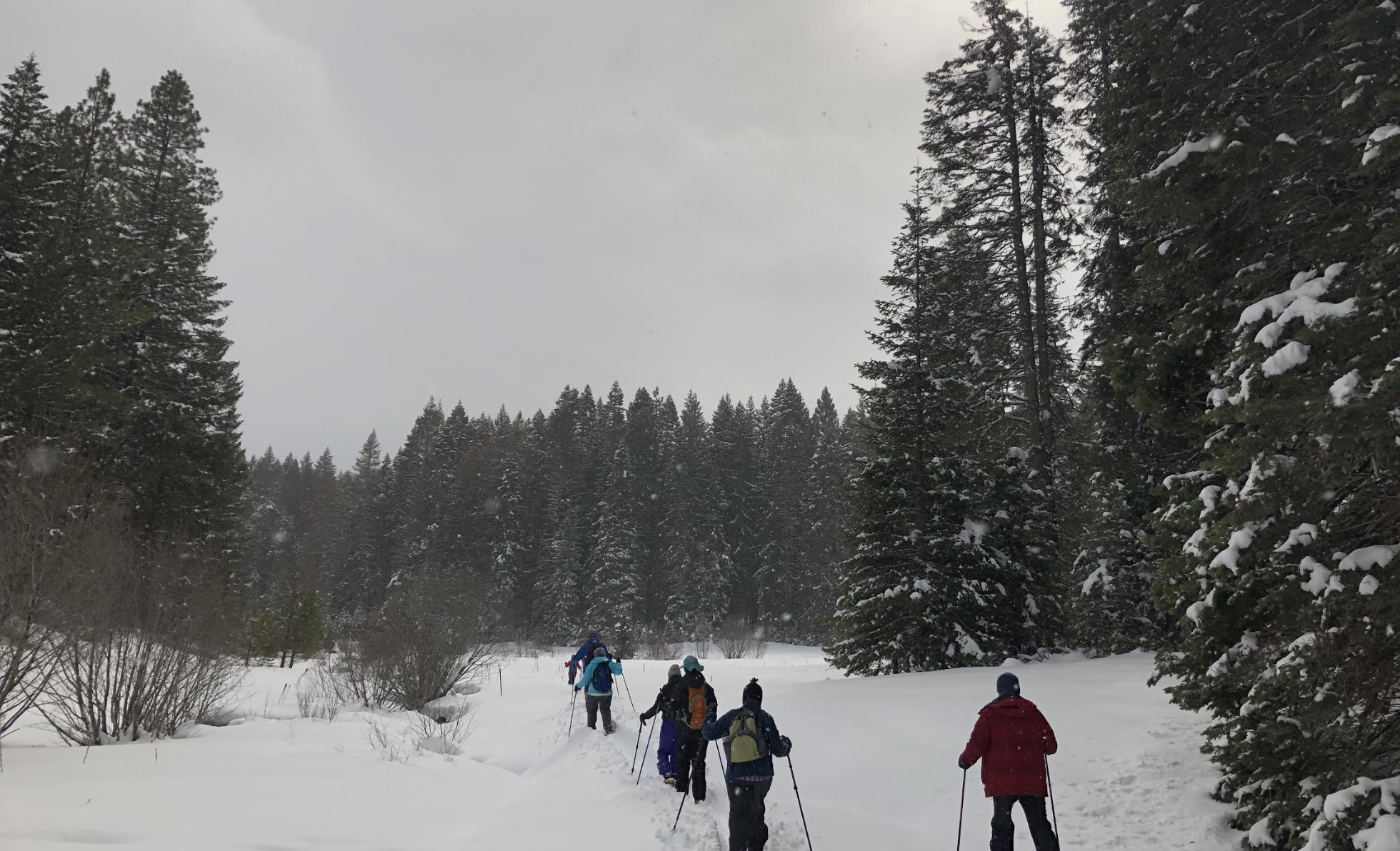
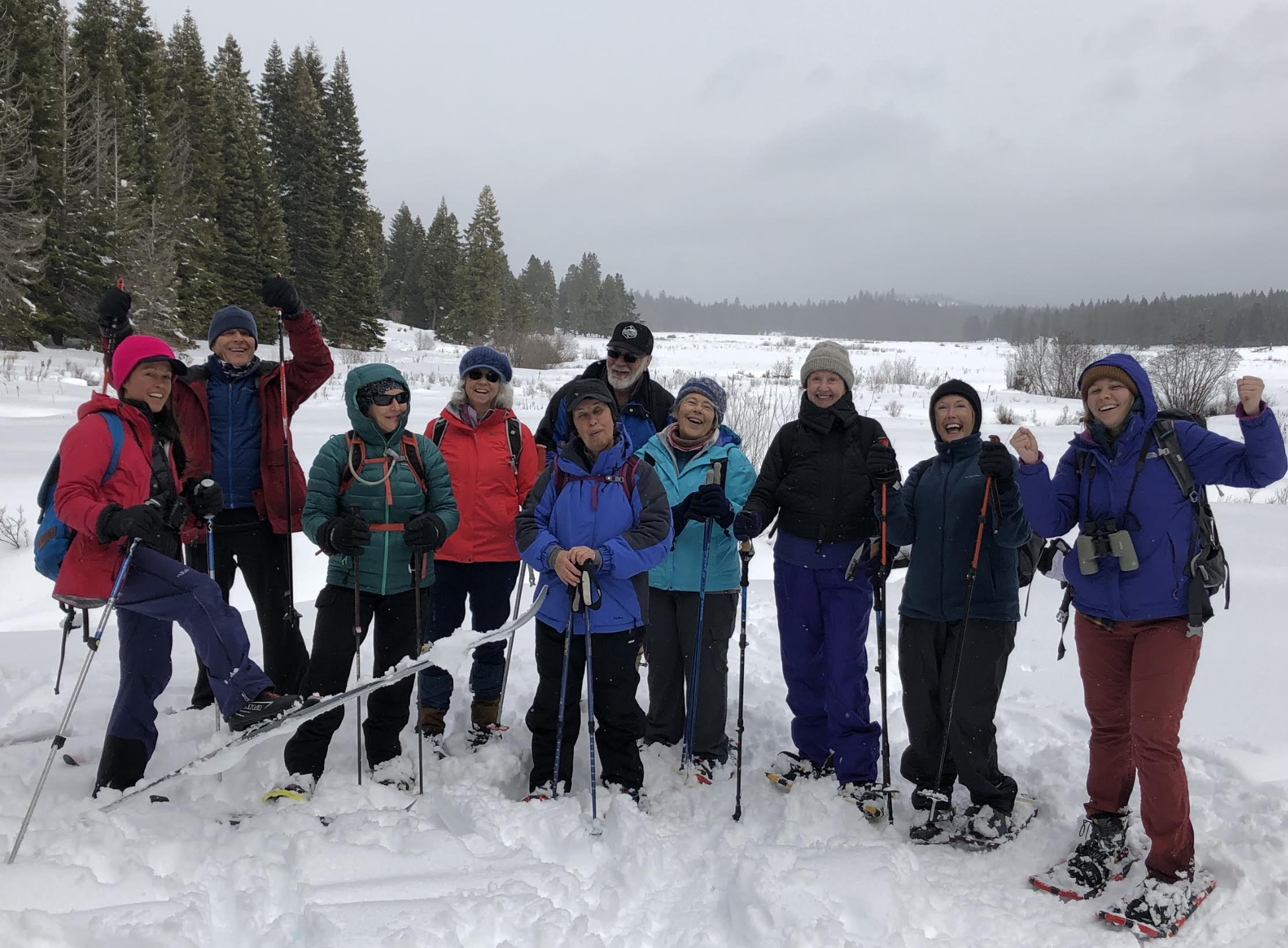
Student Research Topics in the Monument
Searching out squeaky little pikas, analyzing rocks, and studying vesper sparrow genetics-- an exciting and wide variety of scientific research has been taking place within the monument over the past several months.
Each year, the Friends Research Fund awards research grants to undergraduate and graduate students who are interested in pursuing a faculty-supervised project that enhances an understanding, appreciation, preservation, and/or protection of the Cascade-Siskiyou National Monument. Read on to hear from our most recent recipients and see what they have been up to on the monument!
Emily Lind, a graduate student studying Environmental Education at Southern Oregon University (SOU), is studying the Vesper Sparrow with the help of her SOU faculty advisor, Dr. Stewart Janes. She is currently using genetics, morphology, and vocalizations to determine if the Vesper Sparrow population in the Cascade Siskiyou National Monument is the Oregon Vesper Sparrow subspecies (Pooecetes gramineus affinis). This research is important because the Oregon Vesper Sparrow population is estimated to be fewer than 3,000 individuals.
“Throughout the spring and summer of 2018 we captured 26 male Vesper Sparrows at Howard Prairie. We collected feather samples for future genetic analysis, and morphological metrics for all birds captured. We also recorded vocalizations from 25 individuals from the Rogue Basin, Willamette Valley, and Great Basin populations combined. All of this data will be helpful in determining subspecies distinctions between the Willamette Valley, Rogue Basin, and Great Basin Vesper Sparrow populations. Because the Oregon Vesper Sparrow is currently being petitioned for listing under the Endangered Species Act, this research is timely.
We have also been spreading the word about this important research. Two citizen science events brought 16 volunteers into the field to help look for color-banded Vesper Sparrows, and local multimedia artist Daniel Thiede has been documenting the research project. Photos and more details can be seen on the Klamath Bird Observatory website http://www.klamathbird.org/vesper-sparrow, and a Vesper Sparrow Documentary trailer can be viewed on the new Vesper Sparrow Documentary website https://www.vespersparrow.org/.”
Dylan Carlini, an undergraduate student studying Geology at the University of Oregon has been working with his SOU faculty advisor, Dr. Jad D’Allura, to map and geochemically analyze the rocks of the Western and High Cascades. The goal of his research is to gain understanding about the nature of a strange variety of contact igneous (or altered) rocks between two major rock units.
“So far, we have made many changes to the previously published geologic map, which was just a reconnaissance map. We began by breaking out an entirely new unit that had previously been lumped in with a chemically distinct flow. We have also discovered the source vents for separate lava flows for units dating back at least 6 million years, and we have mapped the location of a swarm of dikes (long, linear eruption fissures) that may help us to understand the regional stresses around the monument. We are currently creating thin sections of the rocks so that we may look at them under microscopes in order to analyze the difference mineral assemblages in each flow type. One very interesting product of our field work thus far is that we have extended the range of the Western Cascade exposures by over half a kilometer into what was previously mapped as High Cascade material. “
Neil Clayton, an undergraduate student studying Environmental Science at Southern Oregon University has been researching the American Pika (Ochotona princeps) with the assistance of his SOU faculty advisor, Dr. Jamie Trammell. Through observation of the pika and their surroundings, as well as exploration of possible sites suitable for habitat, he intends to describe the distribution of the species within the Monument.
“My research began immediately following the acceptance of my award this year. I completed a majority of the work that was to be done in the lab in which I used GIS to create maps that may help to describe the distribution of pikas in the monument. These maps were created also to predict the places in which pikas may be found, considering all the habitat requirements. A meta-analysis of scientific journal articles, from historical to current, was conducted. The information extracted from this analysis was used to determine variables that were input into GIS and habitat suitability models were created to predict where pikas may be found. Data was gathered by my research partner from the NPS and their current pika monitoring program. These data points, which represented current, verified pika occupancy in environments similar to the CSNM were used to create a different type of habitat suitability model to predict pika occupancy in the monument. As new data is collected and added to the models, these maps will be combined to show current and historical occupancy in the monument.
I spent time in the field in other locations around the Pacific Northwest with a pika ecologist that works for the USGS in order to understand the way in which pikas are monitored by the USGS and the NPS. I then returned to my sites in the monument and applied these techniques. This was a great help in understanding the distribution of pikas in the monument. With this greater understanding, more data was collected and more questions arose. I spent the entire summer either in the field at pika sites in the CSNM or at other locations in the PNW. There is now a somewhat clear picture of occupancy across the monument, mostly along Surveyor Ridge.
In the spring of 2019, myself and my research partner intend to return to all of the sites in the monument where data was collected in the summer and fall. This round of data collection will help to verify whether verified occupancy at sites predicted by the GIS model is historic, current, or both.”
Come and hear more about these students’ research findings at our annual Monument Research Symposium at SOU on March 14th, 2019! Save the date!
Interested in helping foster student research in the Cascade-Siskiyou National Monument? Donate to the Friends Research Fund today!









